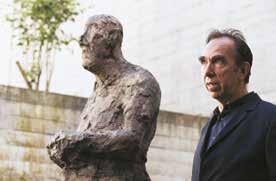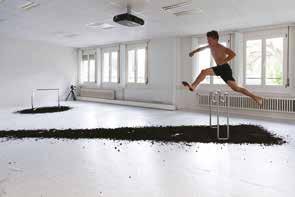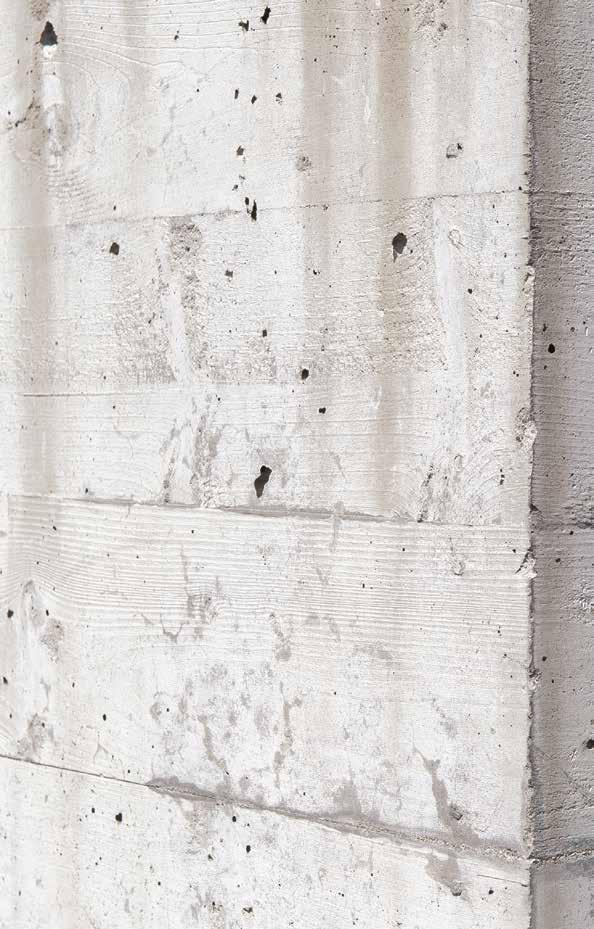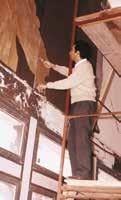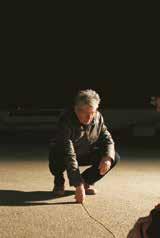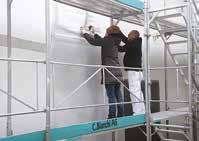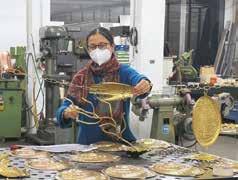








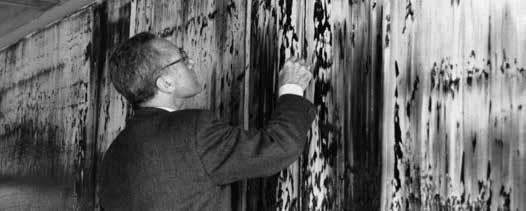
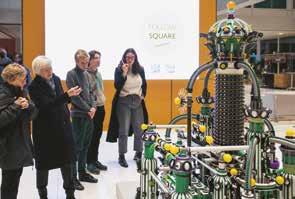
Students and guests explore the new work of art for HSG’s 125th anniversary, Lewis Davidson’s “St.Gallen Clicker” (2023)
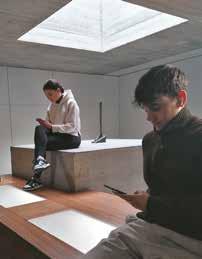
Easy access and integration of art into students’ everyday lives (Alberto Giacometti)
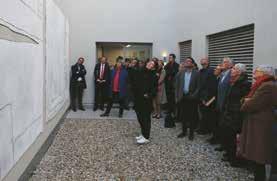
Inauguration of Zilla Leutenegger’s “Lonely at the top”
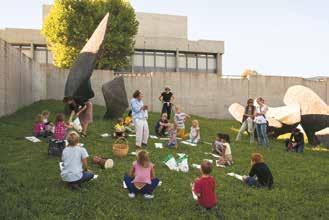
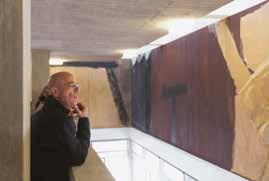
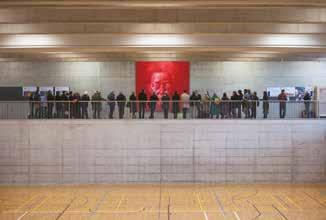

Art is often a matter of perspective, and this is especially true for the works of Ticino artist Felice Varini. His installation “Dix disques évidés plus neuf moitiés et deux quarts” in the Library Building of the University of St.Gallen forms a complete geometric pattern, but only from a precise vantage point. A single step away from this spot, the seemingly two-dimensional image dissolves into fragmented, three-dimensional elements. By integrating his work seamlessly into the architecture of the foyer, Varini masterfully creates an optical illusion that challenges our perception.
Walter Förderer would likely have appreciated Varini’s work. When the young architect won the competition for the new campus on Rosenberg in 1957, he aimed to create a Gesamtkunstwerk, all through his Brutalist design. From the beginning, art was an integral part of the architectural concept. The University of St.Gallen’s extensive art collection was founded through the vision of the then Rector of the HSG, Prof. Dr. Walter Adolf Jöhr, and the jurist Prof. Dr. Eduard
Prof. Dr. Manuel Ammann, Rector since February 2024
Naegeli, who also was the president of the St.Gallen Art Association at the time. Since 1986, an Art Committee appointed by the Rectorate has overseen the continuous expansion and integration of the collection into the university’s growing campus. The committee also manages fundraising, as all acquisitions are financed exclusively through third-party contributions. The University of St.Gallen benefits from a strong alumni network and close collaboration with business partners. Thanks to private donors, the collection has grown to around 80 publicly accessible artworks.
The interweaving of architecture and art is as unique as the holistic approach to research and teaching at the University of St.Gallen. We strive to support our students and faculty in the best possible way, providing them with the space to develop their diverse talents. Art serves as a source of inspiration, reinforcing the idea that science and art are by no means separate domains. Both areas thrive on intellectual freedom and the desire to discover, create, and innovate.
The paintings, sculptures, photographs, videos, and installations on campus offer a moment of respite from the fast-paced demands of study and research. They encourage us to see the world from new perspectives, reminding us that sometimes, stepping outside our own viewpoint is necessary to grasp the bigger picture. Felice Varini’s work exemplifies this shift in perception.
The Rectorate extends his sincere gratitude to everyone who has contributed their time, dedication, and financial support to the conception, planning, realization, and continued development of our unique university campus. The HSG community deeply appreciates the generosity of all its supporters. This art guide is an invitation to explore the University of St.Gallen as a Gesamtkunstwerk and to (re)discover our campus in a new light.
Excerpts from the lecture “The Cultural City” delivered by Prof. Peter Nobel, President of the HSG Art Committee 2003-2012, as part of the lecture series entitled “To whom does the city belong?” (HSG, 28 Nov., 2011)
I am standing in HSG’s main auditorium at the “technical/allegorical bar” created by the renowned—indeed, worldfamous—artist Roman Signer, surrounded bybottles revolving in the breeze generated by ventilators. Looking at this carefully staged, explosion-like sculpture, I would like to take the opportunity to share with you a few thoughts on the beautiful cultural city of St.Gallen and, above all, the remarkable art at the University, which I have visited and experienced multiple times and always valued
. At HSG, world-class art can be found in and around the university buildings. The architecture plays a fundamental role in the diversity of the urban structure, making this a particularly successful example of art in public space and an architectural setting. In this context, we must not forget the true founder of art at HSG, Eduard Nägeli, who was a law
professor at the university. Thanks to his connections to leading artists, he served as President of the Swiss Art Society and played a pivotal role in establishing HSG’s art collection. We should also recognize Franz Larese of erker Galerie, who brought several important artists to St.Gallen, as well as the many private patrons who have supported this endeavor over the years.
This leads me to a question that is frequently asked: What does the term “art” actually mean when it is not simply defined by market prices? 1 When I first grappled with this question, I experienced a deep sense of unease; after all, as lawyers, we are used to work with clear definitions. Art, however, is unique in that it defies all seemingly objective definitions.
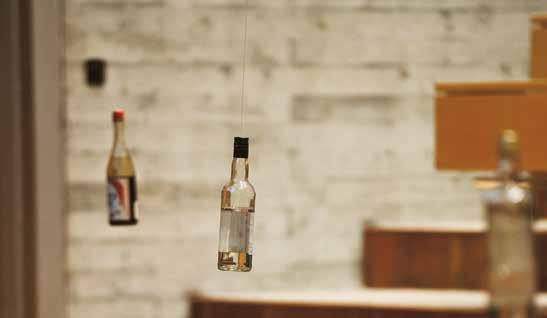
Instead of boring you with theories of aesthetics and somehow attempting to penetrate Heidegger’s “Revelation of Truth in Art Works”, I’d rather quote Peter von Matt’s catchy definition of art: “Where wine grows, there is culture. Wine is always two things: hard work and intoxicated enthusiasm. Both are a prerequisite for art. Diligence alone causes callus, intoxication on its own simply leaves you with a headache. Both together produce a work of art and thus inspire politics. The differences in the interpretations are a source of explosive potential, if the intoxication dominates.”
We must have no illusions and be absolutely clear about the fact that there are no objective standards for assessing the quality or reception of works of art. Instead, we find various groups of consensus, more or less structured, engaged in ongoing debates, each driven
by hidden subjective preferences. These communities of agreement frequently find themselves in intense disputes with opposing groups that hold different underlying tastes. As Willem de Kooning once put it: “In art, one idea is as good as another.”
1 | Excerpts from the lecture «The Cultural City» by Prof. em. Dr. iur. Peter Nobel, President of the HSG-Art Commission 2003–2012, as part of the lecture series «Who owns the city? » (HSG, 28.11.2011)
Roman Signer | «Bar» in Audimax Revolving bottles above four ventilators (HSG, 28.11.2011)
Now the question is: what role can art play in public spaces? What is the relationship of cities, art, and culture with one another? Museums provide structured environments where artistic debates can be channeled in a civil manner. Yet, it is up to us, whether we choose to visit them. In contrast, art in public spaces confronts every passerby, engaging them whether they seek it out or not.
As Christoph Doswald, curator and Chairman of the Zurich working group “Art in Public Spaces”, aptly stated: “Art wants to get out, move about in urban reality, prove itself there. It lives on confrontation and interaction. It needs physical exchange, as Richard Sennett put it in his fascinating 1996 book Flesh and Stone: The Body and the City in Western Civilization.”
Avantgarde art has repeatedly been in the forefront of urban transformation processes. Avantgarde artists are not just pioneers, but also social catalysts. Time and time again, artists are the first to discover neglected urban outskirts, drawing public attention to them. Numerous controversies and scandals reveal just how emotionally charged culture and art can be. St.Gallen
is no exception. I have no intention of telling you the parable of the citizens of St.Gallen, who initially resented the growing international fame of architect Santiago Calatrava’s and the bus stop – a structure they once wished to remove. In the future, however, those same citizens may well install a plaque on the piazza reading, “Calatrava’s bus stop once stood here”.
A similar fate befell another piece of public art. In 1994, after an unsuccessful attempt to install Sol LeWitt’s “The Cube” in Zürich, the Bechtler family, renowned art connoisseurs, proposed placing it on the St.Gallen university campus. Initially, the project met with enthusiasm, but over time, it became embroiled in a populist dispute. Opponents claimed The Cube would block the view of the Alpstein, attract graffiti and so on. Ultimately, the sculpture was relocated to Zellweger Park in the small town of Uster, where it is now appreciated in its new, prominent setting.
Similarly, in 1987, Roman Signer’s fountain – it was a leaking barrel on four steel stilts – provoked outrage among St.Gallen residents, triggering an unprecedented backlash. A letter to the editor declared
the new red cask to be an “alien petrol drum”. There were threats of attacks on it and many mourned the dear old fountain in “Grabenpärkli”. By way of counterattack, renowned curators such as Jean-Christophe Ammann attempted to save the reputation of St.Gallen by embarking at HSG on a series of lectures entitled “Art and Interpretation”.
From today’s perspective, looking back at these events may seem amusing. However, the key takeaway remains: art has an uncanny ability to unleash the primal instructs within us.
Art scandals are not uncommon. One reason for this may be the fact that art often gets selected by a small, self-appointed elite, whose decisions—however well-intended—can sometimes come across as pretentious. Hence, to prevent scandals, it is crucial to cultivate a democratic culture around art – one that is inclusive, explanatory, yet also assertive. Highbrow art keeps its secret, yet precisely all debates about it must be informed by democratic principles.
It is a positive thing when the community addresses the question of art in public
spaces in an organized and objective manner, even if well-meaning committees all too often aid and abet the mediocre when it comes to reaching a consensus. For the sake of artistic quality, both advocates and opponents would do better to confidently flesh out decisions about art in public spheres on a “combat stage”, as art can, indeed should be both explosive and precarious, as Roman Signer’s work so powerfully demonstrates.

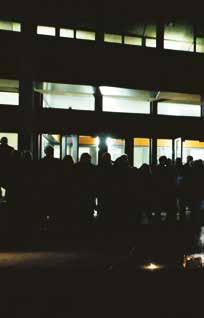

Roman Signer | Explosion in front of the Main Building (HSG, 28 Nov., 2011)
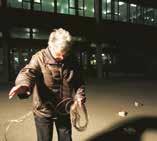
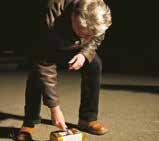


The University of St.Gallen is an extraordinary institution. It is the only university in the country whose graduates, in addition to their academic degree, also carry the attribute “HSG” on their business cards— an indication of the quality of the place where they studied. The University of St.Gallen enjoys a widespread reputation as a prestigious centre for management education. What is far less well known, even among some students, is the University’s exceptional standing as a place for art. In terms of both the number and quality of the works assembled here, one could even consider the University of St.Gallen an art museum in its own right. However, the way art is presented here is anything but museum- like. Strictly speaking, nothing is formally exhibited; rather, the works of art are fully integrated into the architecture and everyday student life. This is meant quite literally, as almost all the works were created specifically for the sites they now occupy, rather than being placed there afterward. The concept of a dialogue between art and architecture is a defining feature among all of the three building complexes constructed on Rosenberg since the 1960s: the Main Build- ing from 1963, designed by architects Walter M. Förderer (1928–2006 Georg
Otto (1924–2003), and Hans Zwimpfer (1930–2012), who at the time were working as a team in Basel; the Library Building from 1989; and the Executive Campus HSG from 1995, both were designed by Zurich-based architect Bruno Gerosa (*1928).
Although artists in each of the buildings created works for specific locations, the evolving architectural styles over the years have also influenced how this core concept has been interpreted. While the Main Building by Förderer, Otto, and Zwimpfer is defined by strict geometric forms— composed of self-contained concrete blocks that seek a formal artistic counterpart—Bruno Gerosa’s later structures are exceptionally transparent, embracing a diversity of shapes that invite a more narrative approach to art. A visit to the individual buildings reveals this evolution – from a dialectic between art and architecture to their convergence –something visitors can experience first-hand.
This transformation reflects not only the artistic trends of each period but also the personal visions and ideas of those involved in these projects.
The former library rises up as a windowless concrete “Tête” above the Main Building

Initially housed in a side wing of the Cantonal School, the University—founded in 1898—was relocated in 1911 to a prestigious building designed by Carl Adolf Lang. This structure on Notkerstrasse in the museum district, was originally conceived for 200 students and soon proved too small. Recognizing the need for expansion, the University Senate began discussing plans for a new building as early as the winter term of 1944-45. However, before these plans could proceed, the financial structure of the former “University od Commerce” had to be restructured. Until that point, it had been primarily funded by the Local Community and the Commercial Directorate, receiving only minimal support from the canton.
A major turning point came on February 13-14, 1954, when the people of St.Gallen voted in favour of a dual financing model between the city and the canton. This decision paved the way for the continued growth and success of HSG.

In 1957, a nationwide competition was held for the main HSG building, which was to be constructed on the former Kirchhofergut manor grounds on Rosenberg. A total of 117 projects were submitted, with 12 finalists advancing to the final round. The jury unanimously selected the design “Tête”, created by the young Basel-based architecture studio of Förderer, Otto und Zwimpfer. Their project won the jury over not only for its architectural language, which combined functionality with expressive design, but also for its thoughtful and measured approach. By 1938, HSG—originally founded by the canton in 1898 as the “Higher School of Commerce, Transport, and Administration”—had been granted the right to award doctorates, officially achieving the same status as other Swiss universities. However, the older, more established universities viewed the young HSG with scepticism from their Olympus of time-honoured
tradition. As opposed to the other universities, HSG had always promoted a practical approach to education. While this approach was embraced by the business community, it was viewed with suspicion by academia. To counteract this perception and reinforce its holistic educational philosophy, the University of St.Gallen placed strong emphasis on broad, interdisciplinary learning. In order to avoid promoting pure specialists, the degree rules stipulated that an obligatory final examination be sat in a cultural studies subject. The aim was to give the students a general education, in which not only their intellect was challenged, but in which ethical values were also imparted.
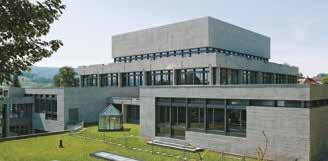

The high-quality architecture and the integration of outstanding works of art make this approach visibly manifest, as the buildings were never intended to be a merely functional teaching space. Instead, they were designed to reflect the comprehensive and interdisciplinary nature of the degree programs. In the building, into which the University moved in 1963, art and architecture were meant to complement and interact with one another forming a Gesamtkunstwerk inspired by the ideals of Baroque, Art Nouveau, and Bauhaus. The strict, geometric cubes of the Förderer, Otto and Zwimpfer design, reflected rational thought, while the art works, many of them created by artists associated with Surrealism, represented the “other side ” of reason: the irrational. At the time, these abstract, sensual, and organic shapes were not universally accepted. If any artistic decoration was deemed appropriate for a University,
it was allegorical representations of the sciences rather than abstract works. Thanks to the successful collaboration between members of HSG, the three architects, and the artists, this revolutionary concept was ultimately realized without major compromises, although, in the early stages, some representational works were added to the collection in place of abstract pieces to accommodate traditional expectations.
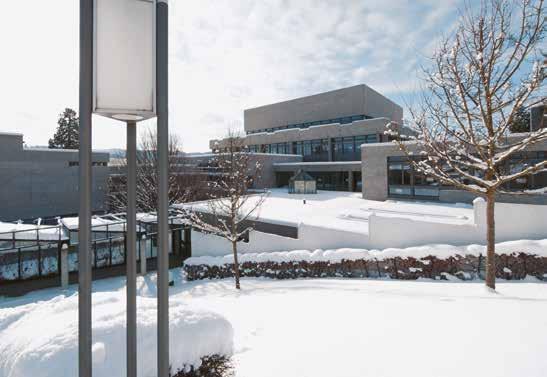
At the suggestion of the then PresidentWalter Adolf Jöhr, the University Senate established an Art Committee shortly before the conclusion of the architectural competition. The committee was chaired by Eduard Naegeli, professor of the Swiss Code of Obligations and Commercial Law and president of the St.Gallen Art Society. It was primarily Naegeli’s extensive knowledge in the field of contemporary art and his connections within the international art scene that enabled HSG to assemble, in the space of only six years, a collection of outstanding works that is still exemplary to this day. For the funding of this ambitious project, HSG benefited from its excellent relations with the business world. Combined with Walter Adolf Jöhr’s great personal efforts and negotiating skills, these relationships made it possible to turn the University’s bold artistic vision into reality.
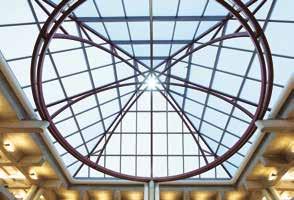

The global attention drawn to the integration of art and architecture in the Main Building also placed a responsibility on the university to develop an equally ambitious concept for future expansions. When the need for an extension became evident, efforts were made to uphold the successful artistic and architectural vision that had defined the original building. Even before the 1981 competition for the expansion was launched, thought had been given about how to carry forward this artistic concept while respecting the existing architectural expression. A certain restraint was expected with regard to the new design, ensuring that the Förderer, Otto, and Zwimpfer building remained the dominant structure on campus. The proposal by Zurich-based architect Bruno Gerosa, who had also participated in the 1957 competition for
the Main Building, ultimately emerged as the winner. As intended, the rectangular extension, which houses the new library and was completed in 1989, lies low against the slope, keeping an appropriate distance from the original building. While the exterior maintains subtlety, the interior and the side facing away from the Main Building reveal a rich diversity of materials and shapes. The most striking feature of the new library is the shimmering glass pyramid which serves as a contemporary counterpoint to the self-contained concrete cube forming the “Head”, of the Main Building.
In autumn of 1986, an Art Committee was established, consisting of HSG representatives as well as architects Bruno Gerosa and Walter Förderer –the latter having maintained a close relationship with the University since the construction of the Main Building. The committee also
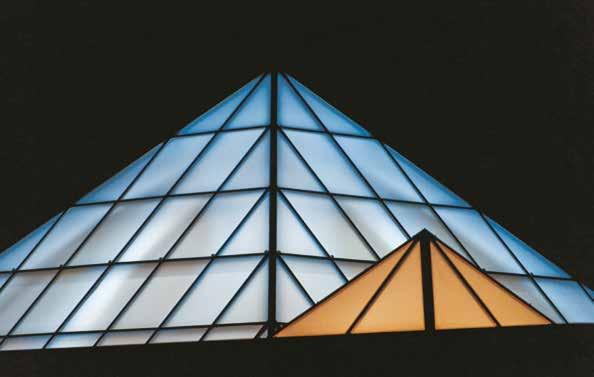
included Rector Johannes Anderegg, Armin Wildermuth, and Philipp Guyer, three professors and lecturers who, with an immense knowledge and strong commitment, tackled increasingly complex strategies involved in contemporary art.
The collection grew to include works associated with Neo-Expressionism and Italian Transavanguardia, movements that revived symbolic and figurative pictorial language. Additionally, the collection incorporated pieces by artists who did not fit neatly into any particular artistic style, reflecting the complex nature of contemporary art. For the Library Building, the Art Committee once again aimed to curate works that would serve as a counterbalance to the conceptual approach of academic teaching. As a result, they largely excluded works that were ironic and self-reflective, conceptual or purely
concrete, even though such works hold significant importance in contemporary art. These forms of art, which primarily engage the intellect rather than the senses, did not align with the University’s definition of the collection.
Unlike in the Main Building, where artworks and architecture engaged in a dialectical relationship, the Library Building’s architecture no longer represents a singular vision of what a university should be.
Instead, the architecture of the Library Building is as rich in allusion, and quotes as freely, as the works of art inside. By the 1980s, artistic pluralism and the blurring boundaries between art, architecture, and science shaped a new approach, one that sought to build upon the success of the Main Building while evolving with the changing cultural landscape.
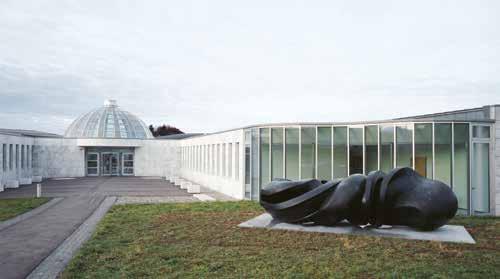
Practice-oriented degree courses at the University of St.Gallen have always placed particular emphasis on executive education. Diploma and Master’s programmes, as well as courses and seminars at various HSG institutes, provide executives and graduates with opportunities to stay up-to-date in their fields. Since 1995, HSG has operated an Executive Campus at Holzweid, built on a plot of land gifted by Max Schmidheiny in 1974. In 1986, Bruno Gerosa, who at the time was busy with the construction of the Library Building, was asked to conduct an initial study for a course centre. His proposal was immediately well received, leading to his later commission for the building’s design. The Executive Campus has been described as a “small late-Modernist garden palace”. Nestling on a hill beneath a glass dome and surrounded by greenery, the two-
wing complex does indeed resemble pavilion architecture in an English landscaped park. As with the Main Building, its extensive grounds allow the exterior to be seamlessly integrated into the campus’s art concept.
Meanwhile, the central Campus on Rosenberg was expanded with a third building, SQUARE, designed by Japanese architect Sou Fujimoto and inaugurated in February 2022. The expansive structure is intended to foster new forms of learning, teaching, and research.
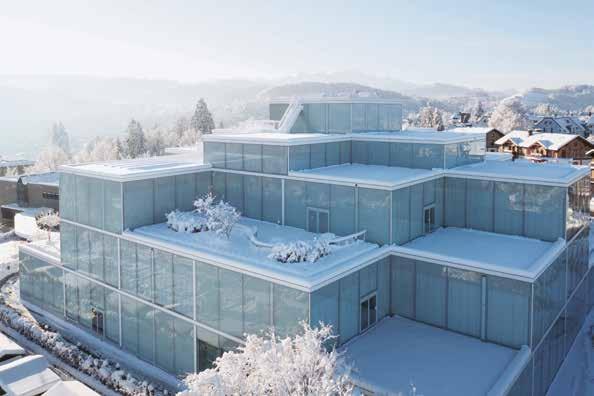
In 1963, the University of St.Gallen relocated from its original site in Notkerstrasse in the Museumsquartier to a new, more modern concrete structure which, given its layout in subdivided zones, was reminiscent of a university campus. The complex itself, composed of multiple individual buildings, is arranged around the central focal point: a knoll within a gently sloping park rich with old trees. The interconnected structures lend an informal air to the complex. Arranged as though placed upon a chessboard, the old institute building, technology block, the main auditorium, the cafeteria, and the historic gym all seem to rise up from the slope, culminating in the single point of the “Head” of the Main Building: a windowless concrete cube that originally housed the library. The window façade, which runs the full length of the edifice, allows muted light to filter into the interior of the building and into the central hall, creating a perpetual ceremo- nious sense of semi-darkness. The sculptural, self-supporting concrete staircase extends across the hall, functions as a dominant force in the space, and leads upwards to the floors above that house the
seminar and lecture rooms. A smaller, separate stairwell provides access to the top floor, which once housed the library but has since been repurposed. Devoid of any view over the surrounding landscape, this space is sealed off from the world, fostering deep concentration. From its central location in the Main Building complex, the Library Building towers over all else and is visible even from afar. It is through the design of this structure that Förderer, Otto and Zwimpfer gave the university its distinctive image, alluding not only to the university’s status at the pinnacle of the education system but also to the teaching practiced here, namely the emphasis on encouraging a primarily rational way of thinking.
In their concept, the architects combined an appreciation of the university as a noble institution of education with a certain sense of monumentality. This was achieved through the reduction of their designs to precise cubes, the surrounding concrete colonnades in front of a sober glass-and-metal façade, and the projecting architraves of the roof cornices and balustrades. They chose not to rely on
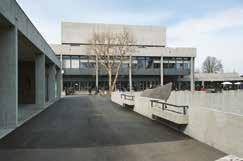

axial symmetry as a defining feature of classical representational architecture. Instead, they arranged the individual buildings in a functional and adaptable manner, integrating them loosely within the natural topography. This layout reflects the diverse needs of a modern university and underscores its role as a dynamic academic community. The structure of the buildings is shaped by the idea that architecture should outwardly express its varied and clearly defined purposes.
This expressiveness is characteristic of Brutalism. An architectural movement that emerged in the 1950s. This term, which has an unfortunate connotation these days, refers to a form of architecture that specifically positions itself in opposition to the sterile and emotionless architecture of International Style, which prioritized purevfunctionality. Several
aspects link the Main Building of the University of St.Gallen to the Brutalist style, such as its figurative language and the way it references the urban and regional terrain where it stands. Not only this, but the way the process of construction itself is visualised, the transparency of the floor plan, the function of the spaces external to the buildings and the reliance on una- dorned materials (fair-faced concrete) are important distinguishing features. It is likely that Brutalism was so named in part due to the French term “béton brut”, meaning “raw concrete”.
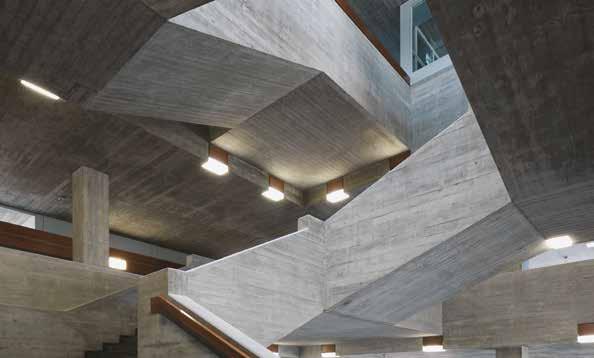
Brutalism was considered a style of architecture that expressed truth and honesty. This perception is partly due to its acknowledgment of the weight and mass of construction materials. The horizontal dimension is emphasised, as is the gravity and the load-bearing nature of elements of the building. Due to the manner in which it accentuates a building’s very construction, Brutalism displays an archaic trait, for the architecture gains a tangibility and expressive force through its strong structure and the emphasis on its material properties. The Main Building of the University of St.Gallen stands out for precisely these sculptural qualities.
In the center of all the Förderer Campus buildings ,a provisional wooden structure was installed on the former parking lot due to an acute lack of space. This temporary building should be removed once the second Campus “Platztor” will start its operation.
The scale and proportions of the Library Building are reflected in its outer form
| Pius und Michael Rast, 1998
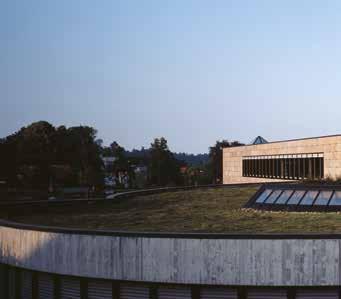
This extension, built to the northeast of the main complex, was primarily designed to create space for a new library, and to accommodate a large lecture hall (the Auditorium Maximum, which can seat 642 students). Bruno Gerosa’s orthogonal, two-section proposal was the winning entry for the construction of the new Library Building. In the eastern wing, the large glass pyramid allows ample natural light to illuminate the two-story library area, which houses bookshelves and student workspaces. In the western wing, the quarter circle forms of the copper roof structure mark the location of the main lecture hall.
Along the northern perimeter, two quadrant-shaped lecture halls are submerged within the surrounding terrain. The modest Library Building allows Förderer, Otto and Zwimpfer’s to remain the dominant architectural element on campus.
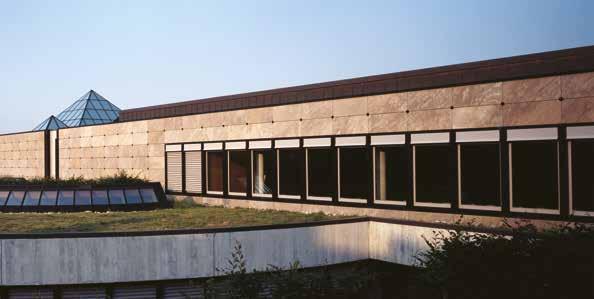
In spite of the 1989 extensions and ongoing adaptations, after more than 40 years, there was no more delaying a general overhaul and expansion of Förderer, Otto and Zwimpfer’s campus design (originally devised with a population of 900 students in mind). In their original form, certain buildings could no longer fully serve their intended form, as they had not been designed to accommodate the university’s steadily growing student population. By 2011, after the modernisation had been completed, the number of students (6,700) had already exceeded the number of workstations calculated for the expansion of the campus (5,000) and, in 2018, this number has risen to 8,600. In addition, the workspaces had to be adapted in line with the Bologna University Reforms to reflect the require-
ments of higher education. The iconic buildings from 1963 had begun to show the signs of age typical for concrete structures: weather-beaten façades and –as a consequence – there was carbonation several centimetres deep in the façades. As this process was starting to reach the iron reinforcements and corrode them, the situation was becoming serious. In 2005, the Canton of St.Gallen passed a bill approving the modernisation and expansion of the university buildings. The five-year renovation, between 2006 and 2011, was carried out in stages, allowing the university to continue operating without major disruptions.
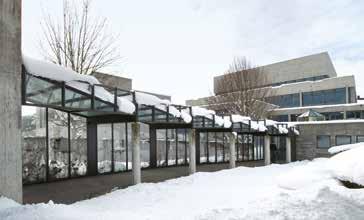
Today, the extent and complexity of the renovation are hardly noticeable when reviewing the sculptural Main Building and its neighboring blocks, seamlessly connected by freestanding staircases and courtyards in all their splendor. The utmost respect was paid to the existing campus as it was adapted to fit the altered requirements, and its substance preserved in all possible ways, which even included the restoration of the original furnishing. Since then, the campus has been officially listed as an architectural monument. Its outer shell, which had been sullied by dirt and weather damage, now radiates a light and inviting impression.
This allows the refined nature of the archi- tecture to come into its own, showcasing, for example, how the structure of the walls is highlighted by means of the ridged pattern created by the seams between the shuttering boards. The Main
Building’s façade is structured by twostoried pilasters and stressed by continuous window strips coloured like fragments of dark-grey scale armour. The chiaroscuro of light and shadow brought about through these elements is now once again plain to see and enjoy, in harmony with the structures. Numerous adaptations of these historic buildings were undertaken with the utmost care in accordance with the latest technological standards and regulations, such as the reinforcement of the Main Building against earthquakes and the integration of a facilities technology centre. As a result, the modifications and expansions remain highly discreet. It is only underground that the scale of the structural transformation becomes evident, with newly created pathways revealing the full extent of the renovations.
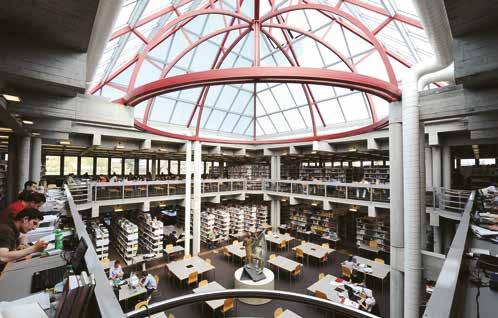
The library is located beneath the large glass pyramid and a dome-shaped structure of steel supports
The most notable conversions were necessary in the areas of the old cafeteria and sports hall. The old cafeteria, in the separate building at Varnbüel 16 on the slope next to the old sports grounds and Kirchhofergut, which had grown too small, now houses the registrar’s office and administrative offices. This place is a central meeting point for students and lecturers due to its central hall, counter area and wraparound gallery. It was possible to move the new cafeteria into the old sports hall thanks to the latter’s relocation and expansion to the neighbouring Ölberg. The project was handled by the joint venture of architects ric ag and Priora General Contractor , who were also responsible for further works on the campus: namely the new underground car park, the service building with its flue exhaust chimney, and the conversion of neighboring buildings. In the old sports halls, there are now three dining halls,
a kitchen and free-flow buffet area, as well as additional seminar rooms and group meeting rooms made possible by inserting a mezzanine built at the same level as the ground floor of the Main Building. The dining halls are divided between the old sports hall, the old changing rooms and the equipment room and are identifiable by their particular colour scheme. In the large hall, which contains approximately 300 seats, a light umber gives the space a peaceful atmosphere; a rich green colour decorates the background of the smaller hall with around 85 additional places, and a dark Bordeaux red makes the separate bar area wonderfully atmospheric. In all three rooms, elegant furnishings in dark wood tones create colour highlights and a formal clarity.
The existing building components, which attest to the architectural vocabulary of Förderer, Otto and Zwimpfer, were

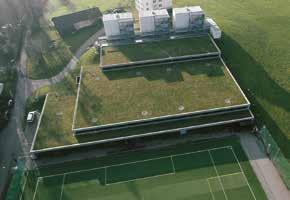
carefully integrated into the new concept and the original expressiveness preserved; the new elements, in their modest conservatism, act as contemporary interpretations of the original design idiom. As such, chrome steel, concrete and black and light grey are a dominant presence in the buffet and kitchen areas and they emphasise the room’s general mood of peacefulness and lack of ostentatiousness. In the summer, you can eat outside in the area in front of the building. Here the large trees in the old parkland provide a wonderful green backdrop.
The spacious new sports complex is situated on the Ölberg at the perimeter of a residential estate in the immediate the victor from the competition was the tripartite sports hall proposed by archi-
tects Lauener + Baer from Frauenfeld, who utilised the gently sloping terrain as part of a structure partly sunken into the hillside. In the grand scheme of the plans for the complete renovation of the University of St.Gallen, the sports hall was admittedly given a different purpose initially: the three free-standing class cubes within a steel skeleton were used to accommodate provisional seminar rooms and lecture halls from 2007 to 2011 in order to allow teaching to continue uninterrupted despite the hampering effects of the various stages of the construction works.
Constituting a “constructed landscape”, as it were, the buildings huddle into the crest of the hill. From a distance, three wide façades and window strips can be discerned, thrusting themselves upwards behind the athletics track which precedes them and, since they are built into the
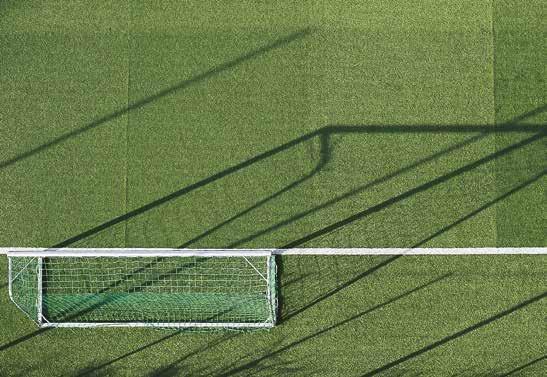
earth itself, just barely reaching higher than the crest of the hill. The sense of architecture and topography melding is reinforced by the plants of the roof areas, making it seem as though the buildings form part of some natural, terraced scenery.
Gently alluding to the campus on Rosenberg, the theme (and it can likewise be identified in the Main Building complex) of constructions designed to converge on a central point where the structure culminates in the “Tête” is varied here by putting emphasis on the horizontal line. The gym it is built into the hillside, with its highest point aligning with the crest of the “Ölberg”. The prefabricated elements of the façade with their laurel branch relief, which were manufactured from insitu concrete, remind the viewer of the textured walls of the Main Building. However, unlike the purely functional
surface patterns of the Main Building, this relief introduces a narrative element: the laurel wreath, historically associated with Olympic victories. This subtle reference, combined with the façade’s interplay of light and shadow, adds a touch of refinement to a structure otherwise defined by its functionality. As such, these elements can perhaps be seen as a small, yet deliberate, architectural gesture.
Upon entering the gym complex, the clarity of the partially submerged interior is striking. It is almost as if the interior and exterior spaces flow seamlessly into one another. The building’s three functional levels which are discernible even from the outside, form a continuous spatial experience thanks to its prominent load-bearing structure. Encircling the tripartite sports hall on the lower level, a gallery with arcades extends on both sides leading to the entry level. In the western
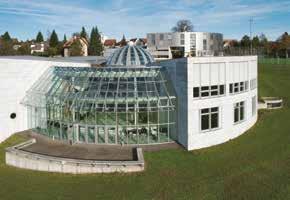
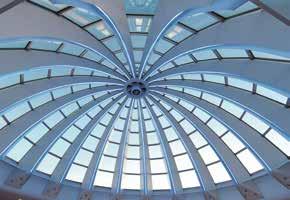
segment, smaller fitness rooms adjoin the upper level. The open interior space is subtly divided by cube-shaped equipment rooms.Daylight streams in through the north-facing window strip into the gym rooms, which are designed for versatile use based on need.
Leading to the entrance, the gallery boasts full-length glazing as it leads towards the sports areas, creating the greatest possible visual merger of the interior and exterior spaces. All three levels of the building are constructed as part of an open, interlocking space, so that there is always something new to catch the eye as the visitor passes through. The contrast of the fair-faced concrete with the warm wood tones of the naturally-treated oak floors of the sports areas, doors and dividing walls creates a harmonious and balanced colour scheme.
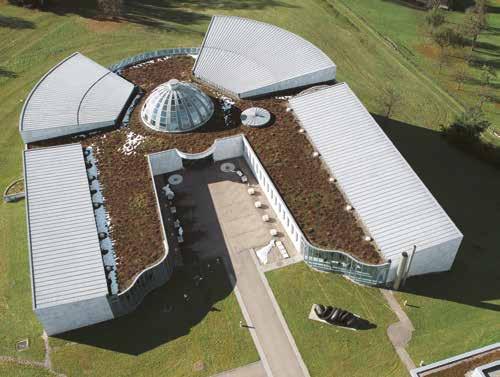
It took more than 20 years from the moment the land on the Holzweid was donated until the Executive Campus of the University of St.Gallen was officially opened. The tale of its construction is fraught with numerous political and financial obstacles that first had to be overcome. Bruno Gerosa was once more required to adhere to the architectural principles of the Library Building, but in designing the Executive Campus, he was given more creative freedom. On this standalone site, the architecture was not required to conform to existing designs, allowing elements of both Baroque and modern glass architecture to merge into an elegant structure.
Beginning at Holzstrasse, visitors first encounter a magnificent lime tree and an old farmhouse on the grounds. From there, a path leads to the central courtyard, which is framed by the two side wings of the U-shaped building. Continuing along this path, one reaches the central dome. The buildings curved wings house the larger lecture rooms and the Intermezzo restaurant, divided between the ground and first floors, while the seminar rooms and office spaces are located in the wings.
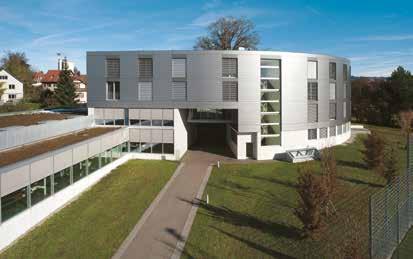
Like the Library Building, the exterior walls are clad in natural stone. However, the use of a lighter stone (a white-veined marble named Bianco Savanna), imbues the building with a more luminous and distinguished appearance. This sense of elegance continues inside, where visitors enter directly into a two-tier foyer visual dialogue with the pyramid of the Library Building. Transitioning from the intimate courtyard into this light-filled space, visitors are met with an unexpected panoramic view of the landscape, framed by a grand glass wall spanning both levels. Whitewashed walls, pale stone tiles, and reflective pools beneath two curved staircases enhance the refinement of this large communal area.

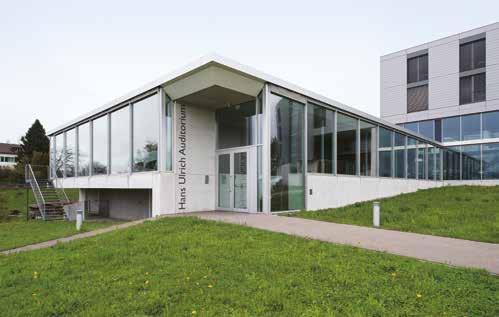
Given the growing importance of the continuing education programme and the rapidly increasing number of individuals making use of its services, the Executive Campus HSG, first opened in 1995, required an extension after 13 years. Bruno Gerosa was once more selected to oversee its design. To the existing Executive Campus HSG complex he added an orthogonal auditorium and a semi-circular campus block with guest rooms for course participants from abroad or distant locations. The compact structure, beneath which the access road leading to the extended underground parking lot is located, circles the entrance area next to the old farmhouse. It extends in a bridgelike fashion, leading to the expansive new North Auditorium to which it is attached.
This design forms a kind of gateway, providing access to the original avenue of the Executive Campus HSG buildings.
Inside, the new buildings are clearly organized and functionally. The modular structure and the larger lecture halls allow for flexible adaptation to the requirements of various executive education programs. At the heart of the new campus hotel is a central lounge area, designed as a gathering space for course participants to meet and unwind. Thanks to its peaceful location, it is an ideal place to hold multi-day courses. As the original Executive Campus HSG, the many seating areas and alcoves of the new building complex invite visitors to engage in conversation.
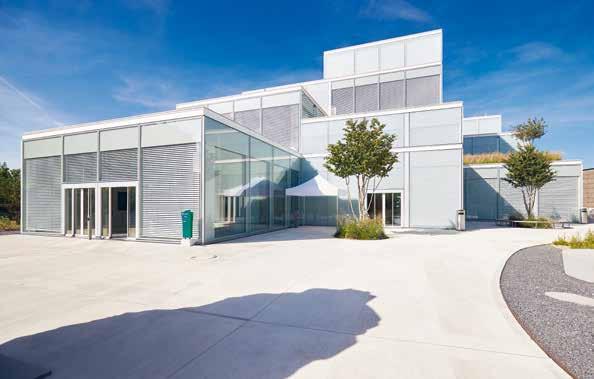
With SQUARE, the campus on the Rosenberg is extended by another striking, architecturally outstanding building. If the Main Building is characterized by spatial sculptural power in rough concrete, and the Library Building is dedicated to classical postmodernism, then the new structure, designed by Japanese architect Sou Fujimoto, presents itself as a playful stacking of cubes made of glass, aluminum, and light-coloured concrete.
For the University, SQUARE is a field of experimentation for new, future-orientated forms of learning and teaching. It also provides a public meeting place and a forum for dialogue—bridging science, society, the economy, politics, and culture. To foster creativity in this new environment, the building includes a public café
and free access to its spaces, alongside a broad program of public events, such as lectures, workshops, panel discussions, concerts, and exhibitions. These initiatives, in addition to traditional teaching activities, create an innovative atmosphere that encourages critical thinking and collaboration.
Sou Fujimoto and his team designed the the “Open Grid” project (competition keyword), an open and lightweight architectural concept that supports these objectives while developing its own distinct spatial identity. In the urban context of the large university buildings and historic apartment blocks, the SQUARE building stands as a distinctive solitaire. The slight elevation from Guisanstrasse and the contrast with neighbouring buildings emphasize its unique position.
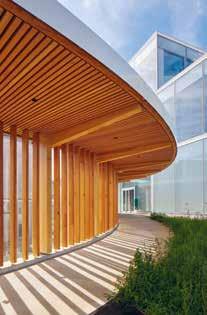
From the street view, its staggered volume forms an asymmetrical, geometrically abstracted pyramid with peaks, plateaus, niches and roof terraces, where each cube is characterised by its transparent clearly recognisable opaque glazed façade and yet becomes a sophisticated whole. Thanks to the volumetric composition, the building fits very well into the residential neighbourhood, creating attractive and varied outdoor spaces.
The main entrance leads into the atrium, the undisputed centerpiece of the building, from which generous, self-supporting staircases lead to the other levels. Open galleries allow for diverse viewpoints, interaction, and an immersive spatial experience.
The ground floor houses the cafeteria, lounge, and open meeting zones, while the upper floors accommodate flexible
learning spaces and pop-up event areas. The interior follows a structured grid of concrete columns and beams, lightened by a high proportion of white cement, and complemented by metal ceiling paneling that subtly references the tradition of embroidery. Built on a modular grid, the design allows for adaptable spatial sequences, offering up to 15 flexible rooms across three levels that foster interactive encounters. The building’s appearance shifts throughout the day, reflecting the green surroundings in daylight, creating an interplay of light and shadow at dusk, and transforming into a luminous beacon at night. Designed with sustainability at its core, SQUARE operates CO₂-neutrally with 65 geothermal probes and PV modules, incorporates recycled concrete and a hollow core ceiling system to minimize resource consumption, and features fully recyclable aluminum and glass façades. The excavated material from
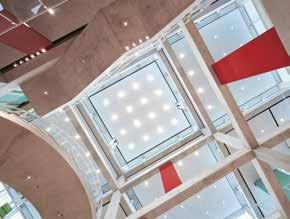

construction was repurposed to shape the surrounding landscape, further embedding the building into its natural setting.
Just as it fosters exchange and collaboration, its funding was a collective effort, supported by over 1,000 alumni, sponsors, and donors who contributed to making SQUARE an experimental space for the future of education and university development.
«Platztor»
In order to secure the future development of the University and continue to fulfil its high-quality core tasks in teaching and research, a second campus will be built on the “Platztor” site adjacent to the northern part of the old town. Its completion is scheduled for 2031.
This new campus aims to provide a functional, operational, and architecturally distinctive environment, integrating contemporary and sustainable concepts for teaching and research while addressing existing spatial limitations. Designed to accommodate around 3,000 students, lecturers, and staff, the project reflects a modern vision for university education. In 2019, the cantonal population approved a 160 million franc construction loan to fund the development, which follows a selective architectural process. As outlined in the
competition program, Platztor will, like the university’s other buildings, serve as a place of art, continuing the St.Gallen tradition of integrating art into its architectural landscape.
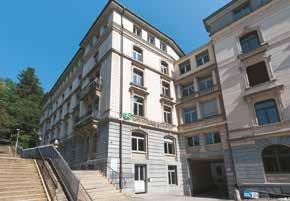
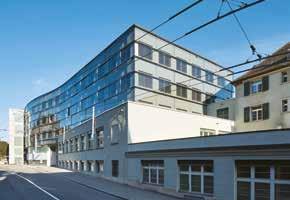
New buildings in the city centre (e.g. at Tellstrasse 2, Müller-FriedbergStrasse 6/8, Rosenbergstrasse 20-22, 30 and 51, St.Jakob-Strasse 21 and Torstrasse 25)
Since the autumn semester of 2013, due to the lack of room capacity, the newly renovated Rosenberg campus, has rented additional buildings in the city center, initially at Tellstrasse 2, where teaching, research, and administration are accommodated.
The 13 seminar rooms, providing 400 spaces and 18 offices on six floors offer proximity to the St.Gallen city center.
Between 2013 and 2018, Tellstrasse 2 hosted an interesting art program called “art@tell” Each year, five emerging artists from all five continents were invited to
exhibit their works in the building. Of the total of 25 exhibited, three were purchased and are now permanently displayed.
In 2017, HSG inaugurated the new building on Müller-Friedberg-Strasse, in which three seminar rooms and the offices of some HSG research departments found space. With innovative office space concepts that are tailored to needs, 350 modern, cost-effective and efficient workplaces were created on an area of approx. 6,700 m2. This building is also adorned with several works by contemporary Swiss and international artists, particularly in its large inner courtyards.

Other buildings house HSG’s two new schools, the Medical School and the School of Computer Science. It is important to the University to maintain its tradition of integrating art into architecture across all buildings. “Haus Washington”, located near the railway station and adjacent to Tellstrasse 2, opened in mid-2024 and is equipped with art photography focused on climate change and climate solutions.
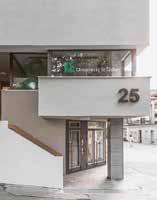
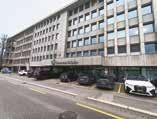
The building’s cubic geometric volumes and the organic shapes of artworks were meant to blend harmoniously with the University of St.Gallen Main Building. What seems clear and straightforward as a theoretical concept, turns as built reality into a complex interaction of two fundamentally different positions, whereby each work, each location is a new challenge for the viewer. This is another way in which the aspirations of the Art Committee and the architects have been met: to make certain the art was not some harmonious “decorative” supplement to the buildings, but instead as a different vocabulary entering into an excitingly confrontational dialogue with the architecture. On touring the building we will perhaps ascertain in astonishment that these works are not staged in a spectacular, but rather in a precise manner. They occupy niches and form unexpected vantage points, they define transitions between nature and the buildings, and between the indoors and outside. Moreover, there are places where art and architecture enter into such a
perfect symbiosis that you cannot say whether the building creates space for the art, or the space is first created by the art. In a way, the art in the Main Building works at a subliminal level: It does not grab us stridently, but sets the tone, and therefore the one or other visitor possibly does not even notice it immediately. Here, works by some of the most renowned artists of the 20th century are gathered. Yet, there are no signs identifying them, as such labels would isolate the artworks from their surroundings and create a sense of distance between them and the viewer. At HSG, art is not merely exhibited; rather, it is integrated into daily life, allowing people to experience it in a way that is otherwise only possible in private residences.
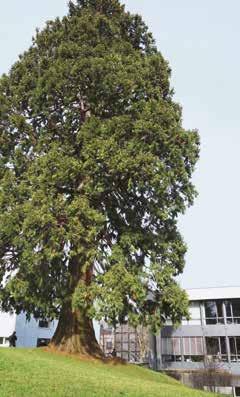
When approaching from the city, your first impression of HSG’s Main Building will no doubt be informed by the history of the grounds. Visitors are not greeted by buildings but by glorious old trees. They stood in the park of the Kirchhofergut manor, which was bequeathed to the City of St.Gallen in 1930 and on the grounds of which the new university was inaugurated in 1963.
Thanks to the harmonious manner in which the various building sections adapt to the slight slope of the former landscaped gardens, the architects have succeeded in preserving the park’s balanced, romantic and in parts classically sublime mood – and using it anew. The seemingly natural and yet completely designed fabric of an English landscape garden is reflected in the architecture, as the sequence of ostensibly chance visual axes typical of such parks is reproduced in
The park grounds with the tall Wellingtonia bring the old Kirchhofergut manor to mind
Photo | Marcel Bischof, 2024
the building complex by Förderer, Otto and Zwimpfer. Despite the massive presence of the cubes, there are forever new views afforded, surprising angles and sudden insights offered. Two crude concrete blocks marking a passageway form the beginning of a broad flight of stairs leading up to the Main Building. Yet before you get there, various paths and hidden staircases invite you to wander around, beckoning like the one or other little place where you can tarry a while.
For example, one path turns off left, and meanders through the rampant bushes and trees of the old park toward a small sunny spot complete with a few wooden benches, on a soft slope exactly beneath the old Kirchhofergut manor. Here, at a place slightly off the beaten track, there’s a classic park setting: Ornamental shrubs create a quiet nook, and a striking sculpture catches the eye. On a plinth,
Carl Burckhardt | «Amazone», 1921-1923, bronze
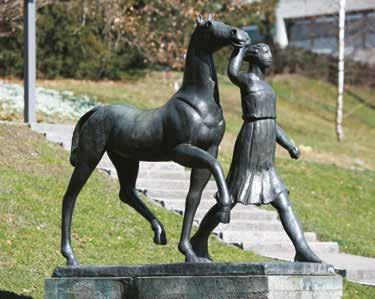
as if extracted from the countryside, stand she bronze “Amazone” created by Carl Burckhardt (1878-1923) – against the backdrop of the nature tamed in the park grounds.
The “Amazone” has a special role within the wealth of artworks in the University of St.Gallen collection, as it is the only one made by an artist who died before the campus was built. Moreover, it is the last work by the major Swiss sculptor, albeit one he did not quite complete. The homage to the great Basel-based artist has therefore been placed in the “historical” part of the grounds, as the preserved Kirchhofergut is likewise part of the university and is used today for meetings and as a kind of clubhouse for lecturers.
A footpath from town leads past this dreamy little spot directly up the hill to the university.
The large flight of stairs takes us to the entrance to the Main Building, whereby most will stop along the way, as on the right there is a huge Wellingtonia standing on its own.

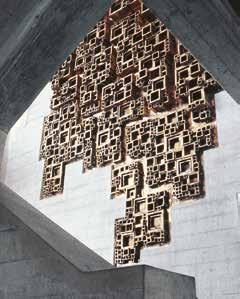
Sequoias can grow for up to 3,000 years, and their soft, reddish bark made them striking features in many gardens toward the end of the 19th century. At HSG, the architects utilized this natural setting by positioning the then ‘institute building’ (now the Presidentr’s office) slightly apart from the other structures, nestled in a small depression behind the Wellingtonia. This placement allowed the building to blend seamlessly into the overall park concept, enhancing the landscape’s harmony.
Behind the reddish-brown fissured bark of the trunk, one spies the clear grid pattern of the windows in the building’s west façade, the stringent structure interrupted by a protruding concrete beam. It is here that a wild knot of coloured metal immediately draws attention: the aluminum sculpture by Umberto Mastroianni (1910-1998) seemingly “floats” on its
plinth-like beam, set against the windows. The sculpture’s hard metallic gleam is softened by its painted surface, creating a visual connection to the painted iron elements of the building façade.Born in Fontana Liri near Rome, Mastroianni crafted a sculpture alive with movement, its Baroque dynamism and intrinsic sense of motion making it a worthy successor to the Italian Futurists. Inside the building, the light is subdued, and from it emerges, with a soft, mysteri-ous shimmer, the brass relief by Zoltan Kemeny (1907-1965). The artwork on the wall of the stairwell links the ground floor with the first floor and with its precious gleaming exterior contrasts with the fair-faced concrete. In the mid-1940s, Kemeny started with the surface of images. If one studies the individual elements of the relief, one sees small open cubes that are countlessly repeated and varied. Given the rows and repetition, the individual element is of
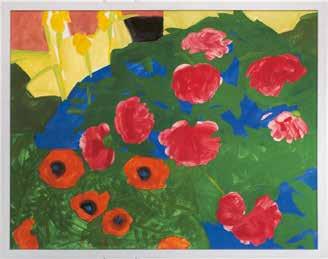
little significance compared with the over-arching pattern or rather the overall fabric of the relief. Kemeny is not interested in depicting one or other of the chance shapes of reality but instead seeks to uncover the very system underpinning the growth of all shapes.
In the same building, behind the door of the President’s office—a space not always accessible—hangs “Blumenbild” by Ferdinand Gehr (1896-1996), a radiant work commissioned by Eduard Naegeli. Painted in tempera, the composition of red peonies glows with the flat, poster-like yet symbolic and abstract style that Gehr, a native of St.Gallen, championed in his renewal of religious art. In addition to these 1960s pieces, the President’s office has, in recent years, acquired a contemporary artwork: Wilhelm Mundt’s “Trashstones”, which will be discussed on page 92.
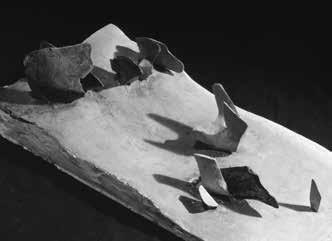

Back on the path to the Main Building, we find ourselves at the foot of the large outdoor flight of stairs, witnessing the no doubt best-known and most photographed view of HSG: Behind the group of sculptures by Argentine artist Alicia Penalba (1913-1982), which dance in a free and playful rhythm across the meadows, a kind of concrete wall screen rises up, the wall supporting the terrace, behind which the Main Building stands powerful and majestic, crowned by a no-frills cube, the concrete “Tête”. The sculptures are made of the same material as the wall behind, but with a coarser- grained structure. Thus, the loose group seems to have been extracted from the edifice, and their organic shapes mark the transition from nature to architecture.
The eye does not suddenly alight on the surface of the wall, but can gradually find its way, offered a basis by the volume of
the 11 wing-like figures, following the movements of the lines and diagonals of the sculptures’ movement across the space, and scrutinize them.
While the stairs initially lead to the smooth surface of the terrace wall, it suddenly changes direction and offers a view out over the countryside. Another change of direction, and it reaches the terrace in front of the Main Building. Exactly opposite the last step, in a protective niche in the building, stands the bronze “Schalenbaum” by Hans Arp (1886-1966), placed on an architecturally shaped platform on the edge of a small pond. In this setting, where the fair-faced concrete collides with the smooth reflection of the water and the open sky competes with the built greys to see which is brighter, the haptic properties of the satin polished “Schalenbaum” comes into their own. Here, the light is diffused

gently, creating a soft halo, a shimmering shroud around the outlines. In the smallest of spaces, the location combines the organic and the built, is to be seen both from outdoors and from inside the building, and thus designates the interface between landscape and architecture. These twin poles are likewise artistic principles to be observed in Arp’s large bronze artwork. The French title “Coupes superposées” refers to two different notions of form, as it can be read “stacked bowls” or as “cuts one upon the other”. The sculpture is defined both by soft, swelling curves, but also by abrupt cuts that savage the budding growth of the shape, replacing rampancy with a rhythmic sequence. Nature inspired Arp in his sculptures yet the organic shapes he created had no direct models in nature. Rather, the creative process follows the Surrealist principle of psychological automatism, the work
ensuing without reflection by the mind, and the artist apparently acting as the medium of a process he does not control.
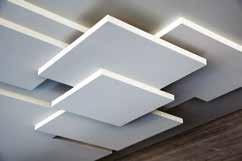
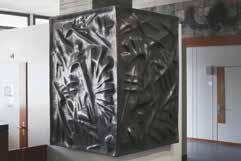
The heavy iron-and-glass doors of the main entrance open onto a large hall: The impression it makes, thanks to the skillful use of light, its height and the sculpture on the staircase, could perhaps best be termed “sublime”. Yet the hall’s monumental feel swiftly gives way to the pulsating life that usually fills the hall. In the midst of everyday student life, it is evident how the dialogue between art and architecture unfolds, as it were, latently. Thus, a chance glance from the entrance to the right through the passageway to the former “technology wing” will discern the outline of a white bird on the wall there: a mosaic called “Oiseau” by Georges Braque (1882-1963).
On the one hand, the image with its radiant strong colours forms a fixed visual point that overcomes the distance of the long corridor; on the other, it gives the hall dynamism, as the bird’s flight suggests a
steady, even motion, something also reflected in the asymmetric position- ing on the wall base. In the 1950s, the theme of a bird is to be found in many of Braque’s pictures, not as an allegory, but in order to lend depth to the pictorial space, which is fundamentally unlike the illusionist pictorial space of central perspective and was developed to fit the spatial conditions of the pictorial surface. The mosaic was realised by Hedy Melano- Högger and is based on a colour etching on which a white bird in a black oval is juxtaposed to an orange “X” such that the bird seems fixed on the pictorial surface, whereby its movement leads away from this captured centre into the unlimited space beyond. If Braque’s “Oiseau” sets the room in motion, in the other direction the eye encounters an artwork that achieves precisely the opposite effect. Etienne Hajdu (1907-1996), like Zoltan Kemeny a native of Transylvania, created a lead
relief: It is a dark gleaming sluggish mass that gives the painted wooden interior of the reception the visual stability required to stand out against the monumental scale of the stairs. Three slabs are connected at right angles to one another such that, seen from different vantage points, they seem to form a volume. And this is not to forget the small ceiling piece made by Baselbased painter Soniatta (1928-1969), a friend of the architect, and located at the beginning of the corridor.
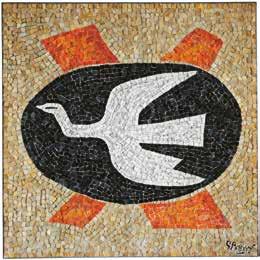

In the darkest part of the entrance hall, positioned between hard-edged concrete pillars, stands something soft and colourful, and glowing. This is the ceramic frieze, approximately 30 meters long, created by Joan Miró (1893-1983) in collaboration with ceramicist Josep Llorens Artigas. Running the entire length of the hall on this side, the frieze appears like an extension of the thin strip of windows encircling the space. With its colourful fields that illuminate intermittently between dark, calligraphic characters, it produces a subtle yet radiant interplay of light and shadow. From 1944 onwards, Miró collaborated with Llorens Artigas producing a major group of ceramic works, including the frieze in St.Gallen. Their work also graces the UNESCO building in Paris, Harvard University in Cambridge, Massachusetts, the Guggenheim Museum in New York and Kunsthaus Zürich. At first, it may
seem surprising that such an important piece remains somewhat in the background, partially obscured by the pillars of the hall side. However, this was precisely Miró´s intention; he designed the frieze to interact dynamically with the architecture.
Since the entire frieze cannot be taken from a single vantage point, viewers are encouraged to examine it in sections, to shift their perspective, and to read the black characters as a sequence, rather than absorbing them in a single, fixed view, as one might with a traditional framed artwork.
The reference to Far Eastern calligraphy is softened by the expressive energy of the gestural brushstrokes, where the black characters, painted bold, sweeping motions, release bursts of diffused colour, scattered in fine splashes.

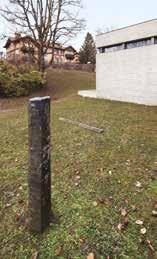
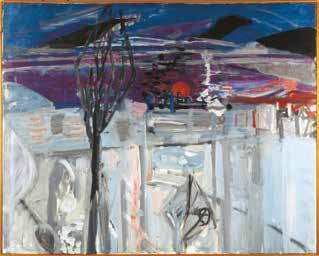
In the rear section of the large hall, the original art programme has been supplemented, as seen through the two windows between the lecture theatres. In 1979, in memory of Eduard Naegeli, two stone sculptures titled “To Meditation” and made by Austrian sculptor KarI Prantl (1923-2010) were placed on a small meadow near Guisanstrasse. The two basalt steles, positioned as columns, transform the otherwise enclosed space – visible only from inside the buildinginto a meditative setting reminiscent of a Japanese garden.
“Night Landscape” by Max Gubler (1898-1973) hangs in the large meeting room and the Zurich-based artist painted it toward the end of his life, harrowed by illness and depression. It shows the view from his studio in Unterengstringen, depicting a barren, icy landscape framed by a leafless tree, while on a red moon
hangs low on the horizon, set against a dark violet night sky.
Pride of place in the entrance hall undoubtedly goes to the sculptural staircase in the Förderer building, which powers upward with its massive diagonals crossing the space.
But before we walk up it to the first floor, it bears stopping for a moment on the first landing and looking down. From here we can see how the artworks in the hall reference the constant coming and going here. They cannot be grasped from a single vantage point, but only really as part of the flow of everyday movements. This is also true of the mobile by Alexander Calder (1898-1976), which seems so massive close-up and yet floats like some refined web in the centre of the stairwell. The primary red of the mobile catches the light that drips over the rods

and the triangular, trapezoidal or oval panes. Ascending the stairs, given the architecture’s turns we repeatedly have different views of the mobile, which oscillates slightly, turning on its own axis. Calder’s mobile juxtaposes the spatial experience of movement to the staircase as a static volume. While classical sculptures with their set volumes express stability and are subject to load-bearing laws, in the early 20th century we saw efforts to make movement a theme in sculpting. Calder’s mobiles are an attempt not only to present the illusion of dynamic processes but make this the very material of sculpture by creating pure “compositions from movement”. Motion as a spatio-temporal sequence was expected to express the fourth dimension in a sculptural idiom, to enable us to experience space in time. Calder also felt mobiles were a way of not fixing sequences of movement
from the outset but having them instead governed by chance.
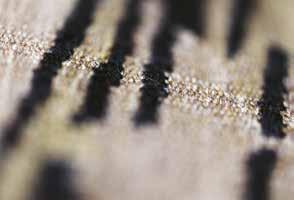
Arriving on the first floor, the soft blue leather armchairs, specially designed for HSG, offer a comfortable place to rest, while the large windows provide a clear view of the Library Building, its distinctive pyramidal roof easily visible. Although this area is not formally separated from the stairwell, it introduces a new spatial atmosphere, shaped by the incoming natural light and the warm hues of the tapestry made by Pierre Soulages (1919-2022). Soulages, regarded as a European exponent of Abstract Expressionism, was a key figure in the “liberation of gesture” in painting, a movement that emerged in the United States in the 1940s.
The bright base tones of the tapestry, combined with its brown, ochre , and dominant black shades, create a warm colour temperature that contrasts with the cool gray of the surrounding concrete.
Here the dark intensity of the dense gestures stands in contrast to the brightness of the window, the dark side of the dense gestures stands in contrast to the brightness of the window, while the open source of the tapestry reflects the soft, sparse light filtering in from the stairway. At first glance and from a certain distance, the artpiece seems like a painting of wild strokes done with a big brush, spontaneous and full of energy, yet, from closer, the viewer discovers in its woven form that this wildness is controlled in every milimeter by the weaver. It retains Soulages’ characteristic balance, his compositions always temper gestural intensity in favor of clarity and stability.
When starting up the narrow steps of the sober stairwell that leads up to the second floor, which houses the study rooms and workstations and the core of the original library (now also a study room, surround-
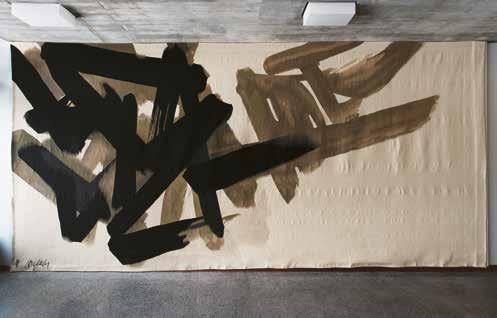
ed by seminar rooms), there is already an anticipatory sense of an almost monastic mood about things: The small staircase, following on from the impressive flight of stairs up from the hall, has the feel of an intimate theatre about it. At the top, one noctices that the concrete cube of the stairs leads us round and serves as the base of a sculpture.
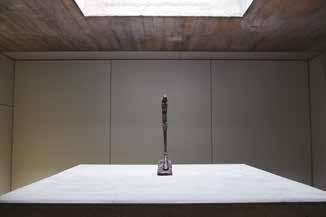
Together with the square skylight positioned directly above the platform, a kind of imaginary space arises for the “Standing woman” by Alberto Giacometti (1901-1966). The architectural staging mirrors Giacometti’s own artistic strategy, where he often placed his figures within cages or boxes, isolating them as if on a stage, emphasizing their solitude and self-reflection. The bronze sculpture rises from a base that angles upward and backward, its slender form emerging from a pair of feet that have fused into a second base, anchoring the almost dematerialized figure within space. In its tense, upright posture, with arms pressed close to the body, the figure appears oppressed by its surroundings, embodying not sensual femininity but a universal expression of the human condition.

Giacometti often repeated that the reality of the world outside puzzled him and he therefore constantly sought to tackle that world and the appearance of things, not in order to depict its contingency, but to trace the human lived reality behind the individual appearance, to find the universal in the particular. Even if the figure is small, it unleashes an immense impact; in fact you may be forgiven for thinking the path up to it simply served to prepare this point of utmost concentration.
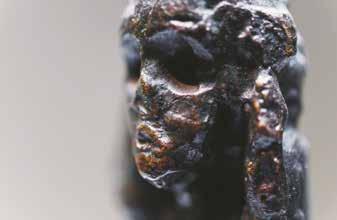
In the former library, art and architecture are meant to interact to create a setting that fosters quiet, focused, not to say devoted reading. It is thus very strange that on arriving on the top floor we are not greeted by some view out, but instead by an introspective place of concentration. Softly filtered daylight enters through a few skylights, directing our gaze not into the distance, but toward the picture panels of Antoni Tàpies (1923-2012). These works, exploring the motifs of doors and curtains, visually and suggestively seal off the walls of the library, reinforcing its contemplative atmosphere. Light from the sides gently illuminates the images, and in the otherwise dimly lit hall, the textures of their surfaces—scratches, cracks, and fissures covered with cloth—become all the more pronounced.
Here, the austerity of concrete dissolves, and the walls seem to reveal traces of history, as if imbued with memory. The 14 panels are not merely paintings but material compositions, pictorial objects. Rejecting illusionistic space, Tàpies employs experimental paint application and surface treatment, layering relief-like textures to create works that do not merely represent reality but exist as tangible objects within it—embodying a new realism.
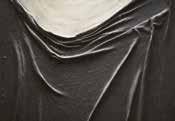
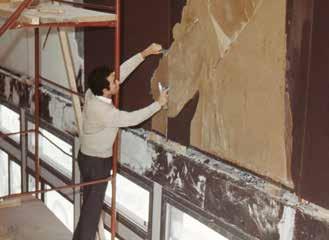
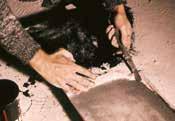


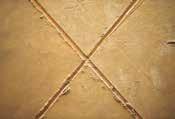

Antoni Tàpies | Untitled, 1962–1963, mixed media, 31 x 3.5 m
Photo | University of St.Gallen, Press and Information Office, 1998
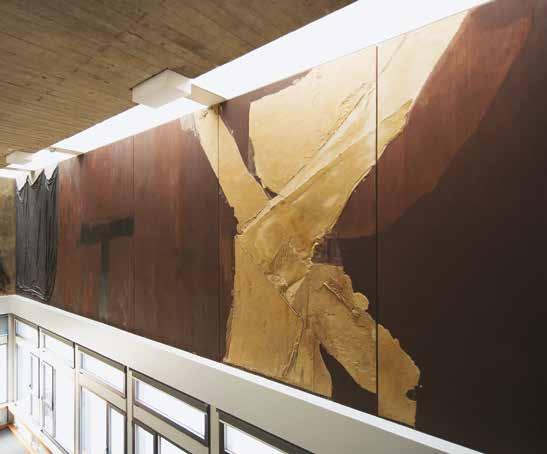
Coghuf | Untitled, 1962-1963, tapestry (realised by Silvia Valentin) page 62


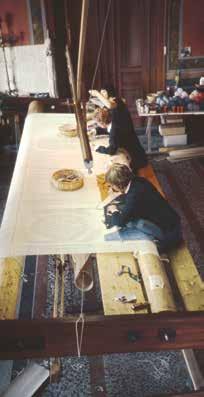
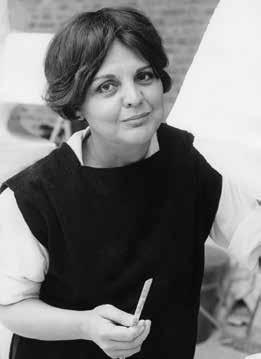
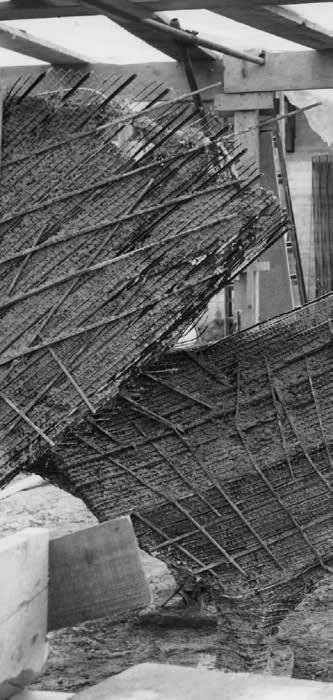
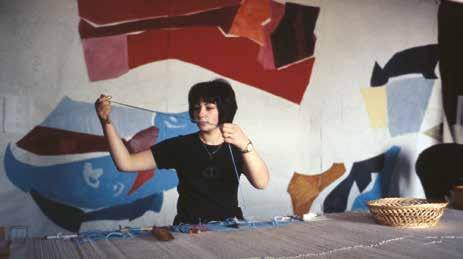
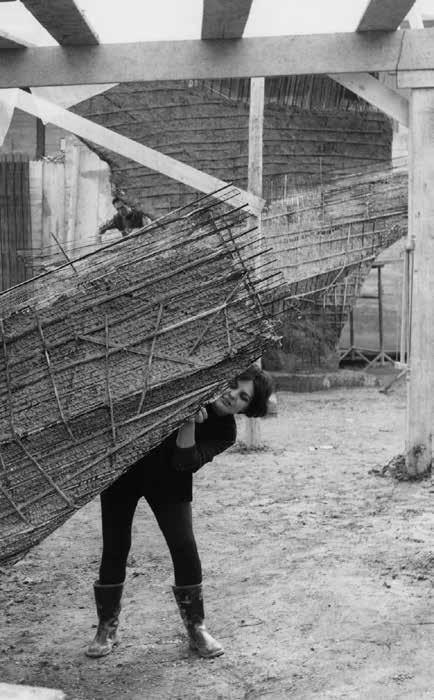
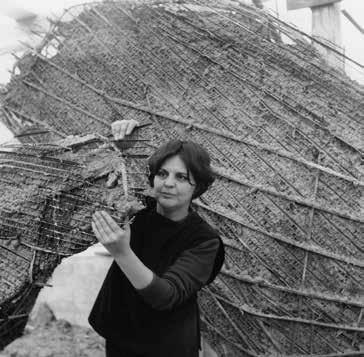
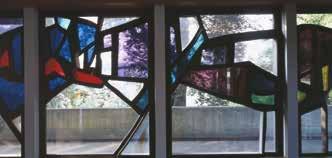

From this central hall in the Main Building we move back, and go outside onto the terrace to view the other buildings in the complex, each with its own function. The Aula stands obliquely across from the Main Building – the art project there is the result of a closed competition with four artists. It has the same façade of iron-and-glass windows and concrete struts as does the Main Building, yet has more of a festive character thanks to the glass window with a sculptural texture that cuts across three sides and is the brainchild of Basel-based Coghuf (Ernst Stocker, 1905-1976) – inside it offers an intense, ceremonial sense of colour. A large tapestry woven by Silvia Valentin on commission for Coghuf emulates the colours and shapes of the glass window. This colourfulness contrasts with a subdued blue and grey ceiling relief made of wood and cement that responds
to the glorious colours like some intellectual, dematerialised reflection.
The entrance to the ecumenical room of worship is on the side with the main doors into the auditorium, with its façade structured carefully by Walter M. Förderer. Beneath a large brass cross, which is part of the design, stairs lead up to the interior, devised completely by Otto Müller (1905-1993). His idea embraces the architecture of the plain, sparingly lit room with symbolic fittings that range from selected colours for the walls and even the design of the liturgical vestments.


A narrow terrace surrounds the lecture theatre, offering a view down to the two building sections below, grouped around the former sports ground- namely the old sports hall, now the cafeteria, and the student administration offices. At the lower end, trees from the old park enclose the square. Against lush green backdrop, a stele stands apart from the natural world of flora.
François Stahly (1911-2006) positioned his “Brunnenbaum” at the intersection between the park and the architecture allowing, the gentle trickle of water to blend into the dense foliage. The bronze figure of the fountain is formed by seven rod-like elements that interlink and in the middle of which the water rises up, spilling out over the stylised shapes of leaves. Stahly moves between free figuration and pure geometry, evoking nature’s shapes,
always placing them in a disciplined geometric arrangement.
The highlights in the sober, no-frills space of the former cafeteria are the metal reliefs by Jean Baier (1932-1999) (page 64). The hard-edged elements, in combination of various reds, blacks and greys, are mounted on the ceiling and walls and on columns, with their gleaming facetted surfaces reflecting the incoming light. They break with the smooth wall sections like so many huge colourful crystals, nesting around the room like so many cheeky shards.

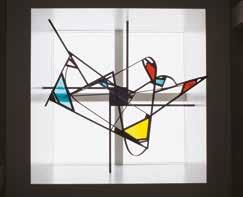
On the upper floor, a gallery with a central skylight, houses Walter Bodmer (1903-1973) suspended structure, which hovers above the opening to the lower floor like a three-dimensional drawing. This iron piece, adorned with panes of coloured glass, captures the light streaming in from above, creating dynamic interplay of form and illumination.
Outside the building, on a small, inviting green space adjacent to the Kirchhofer manor house, stand three “Pliages” in primary red, yellow and blue. Created by Zurich-based sculptor Gottfried Honegger (born 1917-2016), these works were to the collection following the expansion and modernization of the HSG campus in 2011.
Carefully positioned on a lawn near the trees, the sculptures provide a vibrant contrast to the cubic, austere concrete
architecture of Förderer, Otto, and Zwimpfer. They exude a radiant sense of playfulness without overwhelming their surroundings—an expression of an artist whose vision, refined by age, retains the freshness of youthful wonder.
The “Pliages” clearly reflect their origins: before being cast in iron or steel, the models were cut from cardboard. Their geometry bears to the irregularity of the free hand that shaped them, untouched by compass or straight edge in the process. More playfully than ever before in his oeuvre, Honegger relies on light and colour to animate their smooth surfaces, making them come alive with shifiting reflections and shadows.
From the 1950s onwards, Gottfried Honegger’s concrete, non-figurative oeuvre hinged on horizontals, verticals, and diagonals, on squares, circles and
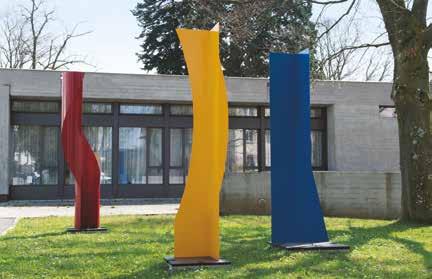
|
triangles, on cubes, spheres and cylinders; he was taught by Otto Müller, who is also included in the collection. For Honegger, geometry is the constructive basis of all life and of the cosmic order. Yet he also accepts that life likes to act against its own laws, by chance and irregularity. These offer an indispensable “emergency exit from the Absolute”. In his paintings and sculptures he does not betray geometry, but points up chance and the irregular, the “unfitting”, for example by casting dice to decide proportions and readily accepting the resulting arbitrary properties.
Later, he was uneasy about the invisible and dark interior of the sculptures, be they solid or hollow bodies. He felt the urge to devise sculptures not as volumes but as surfaces that hide nothing from the viewer. He came up with his “Pliages”, which allow him to render the metal’s folds, bends, milling, welding and screws
tangible to the senses. This wish for “transparency” goes hand in glove with a moral, indeed political stance that expects artworks to behave analogously to the open and democratic society, irrespective of whether they are located in private rooms or in public spaces.
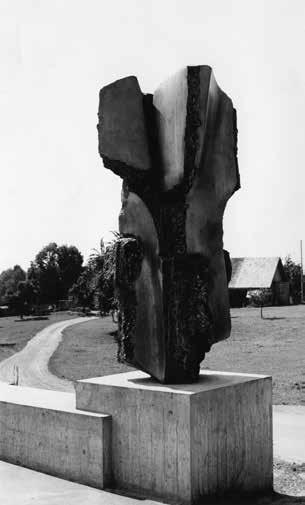
After crossing Varnbüelstrasse, one meets a bronze sculpture by Max Oertli (1921-2007), at the entrance to the sports grounds. Unlike the works in the original art program, this pieces was gifted to HSG in 1971. With its interlocking, smooth and fissured surfaces reminiscent of boulders roughly hewn and pressed together, it evokes a powerful image of primordial forces at play.
The path along the sports ground leads to a new sports hall, where the monumental canvas “Red Self-Portrait” by Yan Pei-Ming (born 1960) hangs on the expansive right concrete wall, overlooking the activity below. The face in the painting is devoid of emotions, locked in silent concentration. Its presence is striking. Not only does the dominant red of the large rectangle stand out vividly against the fair-faced concrete of the wall, but the
interior gleam and resulting astonishing depth of the face intensify its presence in the hall. The facial features appear to be carved from the paint with broad, expressive strokes, while the hair and clothing are only faintly suggested. Despite the portrait’s immediacy, the face remains enigmatic and unapproachable. For Western viewers, this effect may evoke themes of cross-cultural dialogue, where differing cultural backgrounds make it difficult to discern another’s intentions or emotions.
Yan Pei-Ming comments on his preference for monochrome white, grey or red by saying “that’s all I need”. This form of self-limitation gives him “enough power and simplicity” and underpins his penchant for red: “For the Chinese red means good fortune, for Europeans danger, for me violence.
Born in Shanghau, Yan Pei-Ming relocated to Dijon in 1982 and came for his distinctive large-scale formats, restrained colour palette, and masterful use of impasto. Beyond his numerous self- portraits, he has produced incisive- and often unsettling- series of portraits (usually series) of Buddha, Mao Zedong, Pope John Paul II, and his father. His oeuvre also includes portrayals of cultural and political icons, including the legendary Bruce Lee and erstwhile French Prime Minister Dominique de Villepin. Yan Pei-Ming is also interested in reinterpreting masterpeices of European art, such as Jacques Louis David’s “Death of Marat”. In his unmistakable style, he dissolves the image of the inanimate human body in the painting, thrusting it into the limelight with a raw and unrelenting intensity.


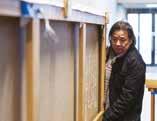



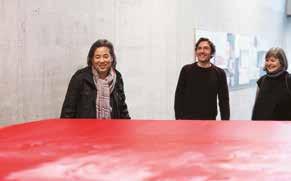
Yan Pei-Ming’s importance in contemporary art is evident from his numerous solo exhibitions across Asia, Europe and beyond, his participation in major Biennales and the many renowned museums that house his works. His presence during the installation of the monumental painting- coinciding with the a sports class in the hall – turned the event into an art happening in its own right.
On the way back to the Campus, in the new cafeteria we come across a series of eight C-prints entitled “Falling Down” (1996), created by US-Swiss duo Teresa Hubbard & Alexander Birchler (born 1965 and 1962) and at almost the same time as we see the Gottfried Honegger sculptures. The images stage, construct, point up and simulate everyday objects falling down.
The vivid energy, intense colours, and the subtly unsettling artificial quality of these images stem largely from the use of analogue studio photography. Contrary to what one might assume, the eight objects appear suspended in mid-air not through computer animation but through meticulous preparation. Each floating object in the foreground is held in place by nearly invisble nylon strings, while the actors— Hubbard and Birchler themselves—pose behind them. Using the traditional technique of back-projection, the entire scene is staged in front of an artificial backdrop. This “fabrication” does nothing to dimmish the illusion; instead, it draws us in completely. The composition feels slightly exaggerated, theatrical, even mysertious. Each object, halted in puzzling almost perfect free fall attracts the eye. By contrast, the figures seem strangely detached from the objects, not emotionally involved, remote, unconcerned.
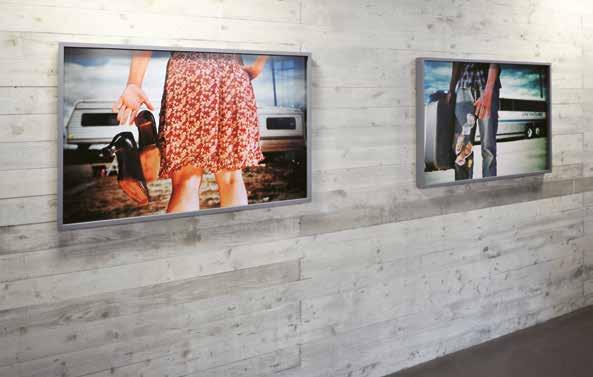
The carefully selected and precisely lit props, the actors’ clothing, each square centimetre of the set, is controlled and synthetically reconstructs something trivial.
Around half of the seemingly surreal motifs seamlessly integrate into their new surroundings, carrying particular symbolic weight within a business university setting—such as the falling coins, the tumbling book, or the cup and bread in the cafeteria. These elements subtly reflect themes of knowledge, commerce, and daily rituals in academic life.
The remaining images, however, transport viewers far beyond the HSG context—perhaps into the world of classic American cinema. They evoke film stills from the 1950s or 1960s, depicting seemingly ordinary, petit-bourgeois characters. The effect oscillates between ironic detachment, a sense of unease, and, at times, a quiet melancholy.
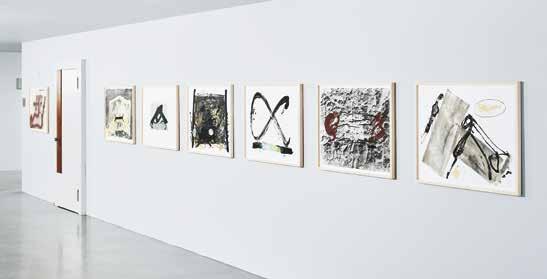
Antoni Tàpies’ (see page 57) deep connection to St.Gallen stemmed among other things from his collaboration with Franz Lareses’ and Jürg Janett’s Erker Galerie as well as Urban Stoob’s lithography workshop. The artist also had his personal doctor in St.Gallen. That Tàpies created his 32-metre-long panel across two walls in the former library on the main building’s top floor was also a reason to hang the lithographs in that same complex of buildings, as a complement to the other work, along both walls of the ground floor next to the entrance to the cafeteria.
Additional prints can be found on the top floor of the building at Tellstrasse 2: Dentelle, a bodice made from brilliant yellow lace as a homage to St.Gallen as a place of textile production, and the academically themed Le lecteur.
Suite 63 x 90 (1980), a sequence of ten pieces, can be inspected along this
passageway between the main building and the cafeteria by students and staff; the motif of footprints reflects the act of passing by. The Greek letter “Alpha” refers to the movement around the artworks; while the letters – along with the larger piece Initales around the corner – establish a clear connection to the symbolic world of HSG. Tàpies’ use of A and T has a double meaning, referencing both his initials and the bond between him, Antoni, and his wife Teresa.
Tàpies’ spiritual and philosophical outlook was influenced by Zen Buddhism and (Spanish) mysticism. He sought to capture “the twilight, the light from dreams and our inner selves.” His work elevates the seemingly insignificant, everyday objects- such as a chair, a pair of scissors, or a pair of shoes – by placing them within a cosmic context. Rendered in subdued tons of gray, brown, beige and
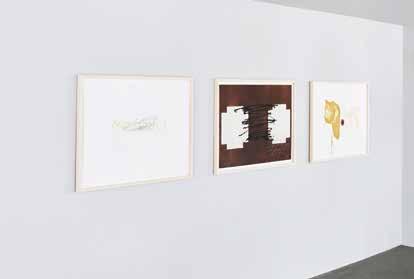
Antoni Tàpies | Suite 63 x 90 (1980), 10 coloured original lithographs, Rives laid paper, 63 x 90 cm and Initiales (1987) coloured original lithograph, 75 x 105 cm
black, his compositions feature restrained motifs that points to a metaphysical dimension. These include the symbol of the cross—representing universality, the world, and wholeness—along with human body parts, particularly feet and legs, as well as letters, numbers, and geometric reflections across axes. Twin symbols further reinforce these themes.The act of deciphering Tàpies’ characters and symbols invites the viewer into a state of meditative and associative contemplation, offering a moment of quiet introspection within his layered artistic language.
On our tour, we now walk down the corridor leading to the old, so called “Technology Wing”, which was repurposed as a passageway to the cafeteria during the renovation of the main building. Several contemporary artworks have since been installed in this space.
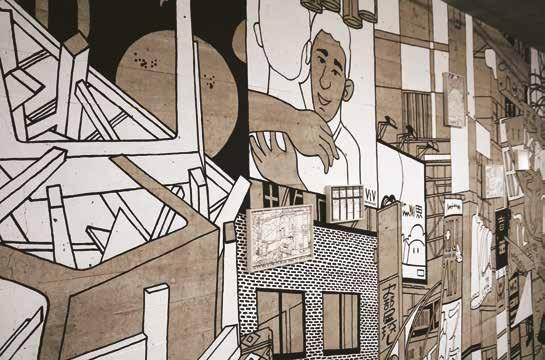
For a passageway below the Aula, Ingo Giezendanner (*1975), aka “grrrr”, created a mural painting in acrylic colour on three cement walls, the biggest one among them on a scale of 653 x 258 cm. The artist chose to elaborate an urban landscape as a fusion of sketches of different cities of the world, among them Tokio, Istanbul, Milan, Karachi, Zurich, and Hongkong. The urban amalgamation follows his personal itinerary as well as notes and drawings in each city. The amplified sketches in the mural paintings will surely open up the confined space under the auditorium, so far a “non-place” (Marc Augé), towards new worlds. Not necessarily an idyllic panorama, but a complex one according to high urban condensation. This effect of spatial compression gets enhanced through a second layer of small, pigmented ink drawings, framed and placed directly on the black and white mural. Ingo Giezendanner paints his experience
of different cities, not concrete, single spaces, more their (somewhat interchangeable) temper or fast and ephemeral atmospheres. Urban overstimulating and at the same time fascinating assemblies, readable worlds, like books with many pages. We see details and snippets of busy activities but also the whole of urban life.
The comics- and street art-inspired murals on both sides of the corridor allow the viewers to physically immerse in this everyday urban panorama of unspectacular details the images (pipes, cables, traffic lights, courtyards, shop windows, advertising signs, and technical installations), far from the tourist trails. The artist himself wishes to draw on the skin of the space in a haptic experience while painting, a process accentuated through the essential, raw cement, the beton brut of Förderer’s building.
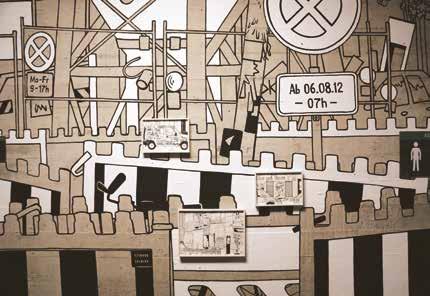
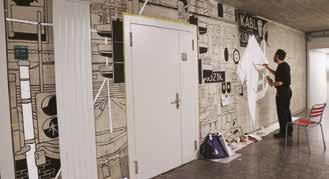
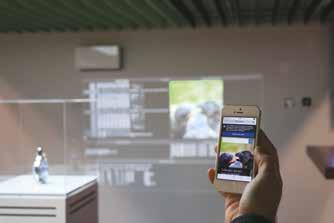
New Zealand artist Julian Oliver (*1974) describes himself as a “critical engineer”. He created his “Transparency Grenade” in the form of a replica soviet F1 hand grenade and equipped it with all kinds of technical instruments: microcomputer, micro- phone, antenna etc., which enable interception of data traffic in the immediate surroundings.
Subsequently the contents of the smartphones, notebooks or tablets are anonymously projected onto the wall, and then deleted from the WiFi network upon their withdrawal. User and host names, IP addresses, decrypted emails, websites, pictures and voice recordings will thereby be visible and give a local impression of constant, automated and individualised global networking. This artwork provides a concrete starting point for the discussion of the transparent citizen, while simultaneously embed-
ding itself in extensive, overarching themes relating to needs, utility, availability, security, surveillance, protection of personal information, access to informa- tion and freedom of opinion, but also continuity and change. For the artist, it is particularly important to project and make visible the very processes that unfold in the background of our smartphones—often without our awareness.
Corresponding to the topic and in contrast with conventionally static “art in architec- ture”, the “Transparency Grenade” appears in various locations across the campus – here and there and most of all: unexpected.
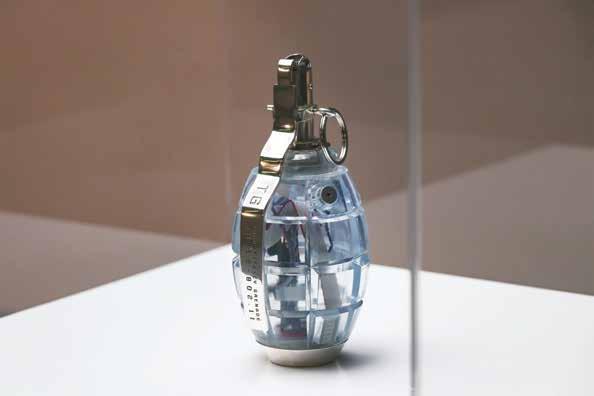
Julian Oliver | Transparency Grenade (2012/17) resin, silver, technical equipment
The underground corridors toward the Library Building take us past the 2010 line of neon writing “happiness is expensive” by Mexican-American artist Alejandro Díaz (*1963). It evokes the image of a doorway leading to a pleasure garden or temple. Yet, there is no entrance – only the illuminated script. Paradise remains just out reach.
If the adjective “expensive” is given a monetary meaning, the text initially reinforces stereotypes that are all too frequently projected onto HSG: the promise of happiness and the threat of expensive products, attractive and repugnant at once. Is the promised thing desirable or the threat to be feared? Does the text refer to the teaching and research at the university—aligning with our thoughts as we walk down the corridor and encounter the artwork—or to the cafeteria, where we seek to satisfy our
Alejandro Díaz | “happiness is expensive”, 2010, neon on Plexiglas, 390 x 45 x 10 cm

physical hunger? Is happiness meant in a physical or mental sense? Should we associate “expensive” with money, or does it refer to the effort and involvement required of everybody to reach a state of satisfaction and gain knowledge and fulfilment? Or is it actually only about the expensive happiness of owning an artwork? Then there’s a possible theological interpretation: The easy path leads to ruin, the tougher one to Paradise: “Happiness is expensive”. There is an additional element introduced here by the reference to neon and plexiglas, both typical materials of an affluent society, one critical of the consumer and advertising worlds.
In Díaz‘ immediate Latino world, many of whom enter the United States as immigrants, living under precarious conditions, the sentence on the price of happiness or the “American Dream” has

quite different connotations. In line with Díaz’ roots, the sentence and its shape also evoke dry southern landscapes that contrast sharply with the grey concrete of the corridor and the coarser climate in St.Gallen.
While the work allows for various distinct interpretations, it actively engages in dialogue with its surroundings, revealing new layers of meaning. Alejandro Díaz’s piece finds fertile ground at HSG, a business university where the concepts of trade and the distribution of goods take center stage. These themes are of particular relevance to the fields of economics, law, philosophy, and business ethics, all integral to the academic discourse at HSG.

Not just neon art, but also video installations have found their place the passageway from the cafeteria to the Library Building. Roman Signer video pieces , accessible from 7 a.m. to 10 p.m., blend suffering and joy, comedy and tragedy, tension and release. They serve as a haunting memento mori intertwined with moments of liberating laughter— sacred humor and quiet contemplation drawing viewers in as subtle accomplices to the artist’s vision. This contrast is particularly evident in the film where 50 toy helicopters, like a swarm of flies, struggle in a chaotic and futile battle, ultimately meeting their end. A similar tension unfolds in the video showing a chair strapped to a mill wheel, endlessly turning, as if trapped in an inescapable cycle of destruction. The videos capture
nature’s unpredictability—its movements, fleeting moments, and one-time events— transforming them into artistic installations.
Roman Signer’s explosive actions may seem spectacular, yet his unobtrusive and straightforward camera work invites us to observe with curiosity rather than mere awe. The videos often build a sense of excited tension, but after witnessing a successful action, one cannot help but question—was it all coincidence, or the result of meticulous planning, careful test phases, and practiced precision? The accuracy of the Tschätterhand, the stroke of a brush on canvas, or the controlled experiment with the hat may appear spontaneous, yet they are anything but random.

Roman Signer | 14 video works, 1988–2011
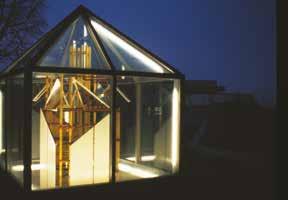
The videos, projected in a continuous loop on a large wall, capture more attention from students than any other works in the collection. Few pass by without noticing them. Students and staff alike instinctively give the moving images at least a fleeting glance, and many pause to watch, drawn in by their dynamic presence.
After encountering these new works in the now-exposed ”catacombs”, we move into the passageway connecting the Main and Library Buildings. There a small foyer awaits boasting a tower to burst from the ground: Walter Förderer’s (1928-2006) sculpture “Nicht betretbare Räume”, a constructivist piece by the architect, who also worked as a sculptor. His sculptural abilities are highlighted in this cabinet of mirrors, which reveals a playful side to Förderer when compared to the architecture of crude concrete blocks for the Main Building.
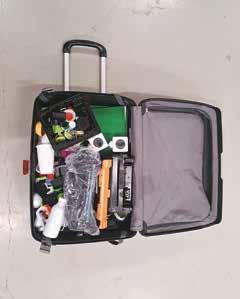
“Technical wing“ of the Main Building
Our tour takes us in the other direction to the former “technical wing“, which was previously an art-free zone, and where now recently installed works of contemporary art appear.
To mark the 125th anniversary of HSG, mixed-media London artist Lewis Davidson (*1990) spent a year collecting plastic waste from employees and students from all over the campus; in the basement in the President’s office, in the cafeteria, in countless offices, the canteen, etc. From this raw material of found objects, “objets trouvés“, the artist built a sculpture of his series “Clickers“. This title refers onomatopoetically to the joining together of the individual rescued plastic pieces, mostly waste, which represent HSG in a playful and humorous way as well as fosters
environmental awareness. The work differs in its precision, symmetry and attention to detail from other works of recycled plastic art, since the last decades of the 20th century, which which tended to show an accumulation of objects, chaotic heaps of plastic. This also applies to the numerous works by artists who place the environmental aspect at the centre of their often marine waste messages.
The sophisticated form of Lewis Davidson’s sculpture is reminiscent of a machine designed by an engineer, a clockwork that could also be interpreted as an image of our institution, with all its links and couplings. The collective contribution of plastic objects from campus could act as a catalyst of a sense of belonging to the community, i.e. employees and students feel part of this interactive work of art because they have contributed the raw material, and therefore identify with the
Lewis Davidson | “St.Gallen Clicker“, 2003, plastic objects and waste collected on Campus, 200 x 200 x 170 cm

new sculptural arrangement of their objects. Countless seemingly incompatible components come together, making it difficult to discern each individual piece, its origin, or its original function at first glance.The “St.Gallen Clicker“ is also the first sculpture at HSG, not made of bronze, aluminum or wood, but made of plastic. The location of the engineering- like sculpture in the so-called “Technik- trakt’, the side wing of the Förderer building, is reminiscent of the former function of this part of the building, in which the students, sons and daughters of textile
company owners, technical and industrial skills such as textile dyeing. Lewis Davidson already attracted atten- tion at HSG 10 years ago with his textile sculpture “18 Flags“,which he exhibited as part of art@tell.
In the staircase, we can discover the “Krüsi“ black and white portraits from 1993 by the world-famous Swiss photographer Hannes Schmid (*1946). The two artists, Krüsi and Schmid, share a similar past in Eastern Switzerland. They come from poor backgrounds, both contracted tuberculosis as children, at the beginning of their adult lives, both were selling flowers picked in the Alps and became self-taught artists.
Hans Krüsi (1920-1995) complemented his floral arrangements with small-format paintings in an Art Brut style, which gradually gained recognition, leading to gallery exhibitions and increasing sales. Meanwhile, Hannes Schmid began to take photographs. After that, the two lives took very different course: “Krüsi“ remained in the region all his life and, due to his fragile health, meant that he had to repeatedly attend nursing homes
and remained under guardianship; Schmid became a world-famous photographer with iconic advertising and fashion campaigns (e.g. Marlboro Man, but also around 70,000 photographs of over 250 pop and rock bands, from The Rolling Stones to ABBA and Frank Zappa).
In the early 1990s, Hans Krüsi and Hannes Schmid met and immediately formed a connection, despite their vastly different life paths. Shortly before Krüsi’s passing, Schmid captured him in a series of black-and-white analogue portraits, documenting their inspired encounter.
These four photographs are deeply moving, as they reveal both the underlying tragedy and the mischievous spark in Krüsi’s eyes and expression—an essence he maintained until the end of his life. Schmid’s empathetic lens captures this
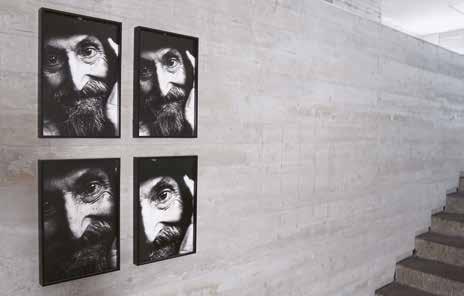
Hannes Schmid | “Krüsi 26, 27, 28, 30”, 1993/2000, Baryt photo paper, 42 x 28 cm
| Marcel Bischof, 2024
duality with remarkable sensitivity, preserving the Art Brut artist’s spirit in a profoundly human way.
A caring yet unshakeable presence—
Hannes Schmid’s crystal-clear view of life is captured in a fleeting photographic moment. Placed in this often dimly lit yet highly frequented passage, the work resonates with a quiet intensity, inviting reflection amid the constant movement of those who pass by.
Half a floor below, just behind the staircase, is the oil painting by the Appenzell artist Hans Schweizer (*1942). Since the 1960s, he has consistently worked at home and abroad in the genres of drawing, printmaking, painting and sculpture, out of which his oeuvre of an impressive continuity as well as diverse motifs and styles was built up.
Always regionally anchored, Schweizer transplants a surreal pictorial world to the Appenzell region. The four figures in the painting “LOST IN AR“ are thickly wrapped, and the whitish colour suggests a wintry, frosty, perhaps icy ground. The colours form a beautiful combination with the exposed concrete. The four enigmatic figures drag their mysterious loads through a diffuse environment and actually appear somewhat “lost“. Some of the figures are carrying a shoulder bag or suitcase (with painting utensils or setting
off on a journey?). But in three cases, these objects elevate the image to a meta-level: a canvas within the canvas, revealing the typically unseen backs of paintings. These elements could also be interpreted as windows to the world, serving as a symbolic reference to art itself. The figures move in four different directions, sometimes marching purposefully bent forward, then again wandering around and yet following some sort of an everyday routine.

Hans Schweizer, “LOST IN AR”, 2009-2010, 2009-2010, oil on canvas, 101 x 145 cm
There were previous attempts, at the beginning of the sixties, to bring one of Hans Josephson (1920-2012) works to HSG. In the HSG archive there is a correspondence to this end between the architect Walter Förderer, Prof. Eduardo Nägeli and Josephsohn. Since 2017, the revival of this plan has stood by the rear entrance of the engineering wing of the main building, in the form of “Baumann”, a larger-than-life sculpture of a worker that bears the name of the model it was based on. The varying perspectives – on one side from Curti-Strasse, on the other from the entrance of the engineering wing – create distance and close proximity to the sculpture. The concrete backdrop provides the figure with an optimal platform and in turn “Baumann” affords the thoroughfare an intense atmosphere through his strong physical presence. The worker was created at precisely the same

time that the main building was constructed and inaugurated, in 1962. The fact that the bronze sculpture fits so symbiotically into this environment thus rests on a historical coincidence.
The decision to position the worker here aims to heighten students’ awareness of the tangible, physical nature of labor—an alternative to their academic pursuits and predominantly digital activities. Baumann’s posture embodies the weight of a long, physically demanding life, his bowed shoulders and weary stance conveying both strength and exhaustion.
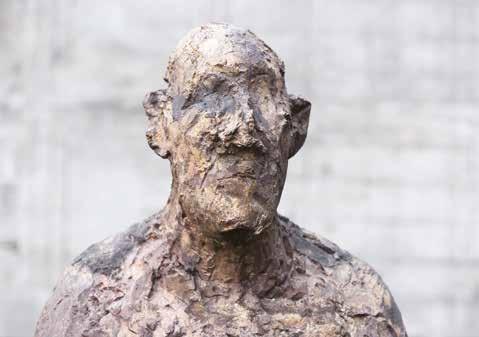
In the stark, cool concrete surroundings, the figure’s presence is striking, a poignant reminder of the endurance and resilience inherent in physical labor.
Hans Josephsohn’s lifelong commitment to artistic independence and his detachment from the commercial art market carry a significant message for students. His work reflects the idea that from the very beginning, the project was not about art as an object for investment or trade but rather about its long-term integration into the everyday life of students at the University, many who do not necessarily have an affinity for art.
The casting was carried out by the local Sitterwerk artistic foundry, following Josephsohn’s precise instructions. Renowned internationally for its exceptional
craftsmanship, the foundry collaborated closely with the artist for many years and continues to preserve and uphold his artistic legacy.
In his younger years, HSG Professor Hans Christoph Binswanger, who passed away in January 2018, often discussed art and, above all, economics with his neighbour Josephsohn in Zurich, which even influenced him to pursue his course of study. From the many discussions about art the young Binswanger obtained from Josephsohn numerous ideas, including how to recognise the sculptural quality of the heads on figures: “You have to look at the ears and take note of whether the head and the ears form a single entity or if these have simply been stuck on. That speaks volumes.”
Günther Uecker | On the Silence of Writing or Speechlessness, 1979, 21 sheets, 45 x 45 cm, 17 offset and handmade screen prints, following photographic transformations, 3 handwritten facsimile pages of text, 1 page of text from Eugen Gomringer, 50 x 50 cm (gift from the Erker-Galerie to HSG)
Sociopolitical concerns connect the art of Antoni Tàpies and Günther Uecker – the revolt again totalitarianism and fascism. Uecker experienced existential threat and violence early on in his life. The quote from the Russian writer Vladimir Mayakovsky, “Poetry is made with a hammer,” was practically a leitmotif for him. He frequently incorporated the hammer in his work, using it to drive one of his most significant artistic elements— the nail. For him, nails served as “seismographs of his inner mental state,” capturing his emotions and psychological depth through their placement and presence in his pieces.
The graphic work On the Silence of Writing or Speechlessness consists of reproductions of photographs taken by Lothar Wolleh in 1978 in Galerie Rekermann, during the exhibition of Günther Uecker’s Silence Sculpturein Cologne,
and painted over by Uecker himself. The loose sheets are placed in the stairwell of HSG’s provisional teaching space in such a way as if to suggest that they were specially designed for this space. They show a “reading room” that, among other things, contains a table, a lectern with an open book, nine reading desks along the wall and six blocks of newspapers. The entire surface of the table is strewn with nails whose points are directed upwards. Paper sheets, which have been rendered unusable by perforations from the nails, are displayed on the reading desks along the wall. Even the book and the newspapers have been nailed, thus preventing the possibility of reading them. Writing, that is the transformation of language into symbols, is denied, extinguished. Instead, silence is given a pictorial form and becomes a sensory experience. A space for perception, reflection and communication emerges here, outside

the spheres of influence of writing and language, outside the corset of syntax and semantics, of ideology and doctrine.
Günther Uecker’s scepticism of writing and speech manifests itself as a prerequisite of all types of ideological criticism.
“In the beginning was the Word,” opens the Gospel of John, yet Günther Uecker remained constantly skeptical of the dominance of language.

The dark entrance to the President’s office and administration is brightened by the white stone. However, it is connected with the small black stone, located further up: Light and shadow. German artist Wilhelm Mundt (*1959) has deposited two of his “Trashstones“ here. These are created by the artist packing waste from his studio into layers of polyester and fibreglass. The top and bottom of the sculptures are held together with tape which becomes visible, after these layers have been sanded off. The contrast between the repulsive waste content and the aesthetically decorative high-gloss shell creates a tension. The glimpse between the layers of fiberglass and polyester offers a view into the interior of the stones, yet their contents remain hidden—known only to the artist. Each stone bears a number, allowing him to identify it through a carefully kept list of its various contents. Through the
process of recycling, the artist’s personal waste is transformed into something of public significance. The external form, with its smooth, glossy surface and soft contours, is highly aesthetic and invites a tactile, physical interaction. Yet, the thought of its possible contents introduces hesitation—making us question whether to touch the stones. The numerical sequence assigned to each stone further grounds the work in an administrative, rational framework, contrasting with its organic and mysterious nature. Stones are something old, of the past. This corresponds to the content of the trash stones. In contrast, the material of the surface, polyester, points to modernity. With these contrasts, they remain tumbling stones, links between the past and the present, present and the future.

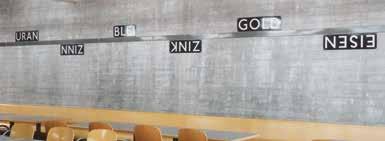
Even though the Art Committee initially sought to extend the artistic vision realized in the Main Building, it is evident that the evolving state of the art world led to a significantly different outcome. By the 1980s, artistic expression had moved beyond the aesthetic formalism of Modernism. Site-specificity, once a defining principle, began to give way to more symbolic interpretations. Rather than solely engaging with their immediate surroundings, artworks increasingly embraced open, narrative structures, where expressive, self-contained forms encouraged broader interpretations. This shift mirrored developments in architecture. Instead of a deliberate contrast between art and architecture, the two became more fluidly intertwined. Paintings sprawled across entire walls, sculptures obstructed pathways or occupied central spaces—not as disruptions, but as natural extensions of an architectural environment spacious enough to accommodate them. While the Main Building sought a holistic synthesis of art and architecture—a Gesamtkunstwerk—achieved through carefully placed compositions, the Library
Building fosters a more organic integration, dissolving rigid boundaries. The strict canon of Modernism, which still governed the Main Building, gives way here to a more playful engagement with forms, materials, and references. This evolution is even reflected in subtle details, such as the small bronze plaques embedded in the floor, inscribed with the names of artists, artworks, and sponsors. Rather than distancing the observer, these labels invite engagement—acknowledging the historical relativity of art presentation and encouraging a deeper interaction with the works.
Having left Walter Förderer’s sculpture behind and having passed an connecting corridor, we reach the Library Building. We enter the expansive, bright, though seemingly not very high hall. Our gaze wanders along the radial structure of the floor, moves on to the corresponding concrete ribs of the ceiling, and is drawn into the room. The foyer consists of various segregated zones through demarcated structures on the floor and ceiling. The entrance area includes a cafeteria on the left hand side next to a window recess.

Lothar Baumgarten (1944–2018) chose the curved wall of the “Auditorium Maximum”, which wraps around a cloak-room , as the starting point for his work “Steinschlag”. He adapted six plinth-like wall screens to follow the curvature, attaching surrounding stips of enamel panels, so inscribed with terms such as Schubfetzen” (‘fallen parts of the overlying rock’), “Schneegrenze” (‘snow line’), “Malachit” (‘malachite’), “Leitgestein” (‘lead stones’), “Onyx” and “Malmzeit” (‘Malm times’), well-known to unfamiliar sounding terms from local geology, meteorology and mineralogy.
Inspired by his first sight of snow-dusted hilltops around St.Gallen, the artist discovered the sprinkling of snow covering the higher regions in the hilly surroundings of St.Gallen. Baumgarten reflected on the stratification of rock, the prehistoric movements that shaped the landscape, the shifting colours of the seasons, and the schematic forms of geological maps. In its abstract composition, Steinschlag evokes this deep history of natural transformation.
Configured differently, above the long bench in the cafeteria grey plaques display the names of heavy and precious metals: “old”, “Iron”, “Titan”. As if on a conveyor belt, the plaques seem to be continually rotating. On the wall to the right of the entrance, rectangular monochrome plaques visualise proportions and crystal-line growth. In his work, Lothar Baumgarten is like a traveller who imbibes impressions impartially before spreading them out in front of us. What at first seems like a puzzle, is a work fully engaging with the context. To a certain extent, Baumgarten follows the tradition of Romanticism and Enlightenment, combining science and art in his oeuvre.

To the left of the cloakrooms, a narrow corridor on the left leads to an entrance to the Auditorium Maximum. Beyond this entrance the corridor widens into a small lobby, the foyer of the two lecture theatres halfway beneath the terrain. With regard to artistic interventions we encounter different positions in two spaces that in terms of architectural concept are almost identical. In the Senatsraum on the left Martin Disler (1949-1996) created a work entitled “Usura”, two murals painted directly on the concrete not with brushes but using hands, which emerged in an ecstatic ejection of amassed energy following intensive investigation of the place in a single night. To the left and right, splurges of red and blue paint flank the room. From this riot of colour, fragments of figures and bodies occasionally emerge which, no sooner has one recognised them than they dissolve again before
reappearing in another form. The images are reminiscent of a Baroque descent into hell, but can also be seen as a metaphor for the act of painting itself, as the representation of the creation of a picture that is never concluded. As the third part of the work, Disler attached a head made of plaster to a column before the glass front, above the lettering “USURA”, which, is also emblazoned, back-to-front, on the forehead of the grotesque mask. Usura means interest and usury, but also excess and could be interpreted as a principle of Disler’s oeuvre, as the “extra” that emerges between what went into the work intentionally and what is only revealed in the production process.

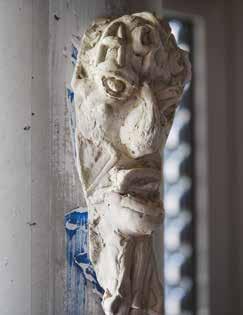

The atmosphere in the adjacent, somewhat smaller lecture theatre—donated by the St. Gallen Foundation for International Studies (ISC) atHSG along withwith the artwork—is entirely different. In it two oil paintings by Max Bill (1908-1994), “verdichtung gleicher farbquanten” (1991–1992), likewise created specifically for the location, make a very distinct mark. These are two small pictures with bright colours hanging opposite each other; the way they are structured with triangles facing in opposite directions produces the same quantity of coloured spaces. Max Bill was present as they were hung, high up close to the exit, as he desired. To a certain extent the two pictures enjoy a special position in the Library Building’s art collection, as we recall that the Art Committee was hoping that the works for the new Library Building would represent the embodiment of non-rational thought. Bill, on the other
hand, was of the opinion that in art it was possible to apply a “logical method”, in which “each part of the creative process corresponds step by step to logical operations and the examination of the logic behind them.” That does not mean, however, that Max Bill’s pictures are self-sufficient arithmetic exercises; he was far more concerned with using art as a means of making elementary structures and forces sensually perceivable.
Leaving the lecture theatre we see that the solitary wooden figure balancing precariously in a kneeling position on its sphere in the small foyer illuminated by a sole skylight is part of a group of works by Josef Felix Müller (born 1955). The male figure is peering in the direction of the narrow corridor connecting the Auditorium Maximum and the library. At the end of the corridor it catches sight of a counterpart positioned on a small balcony
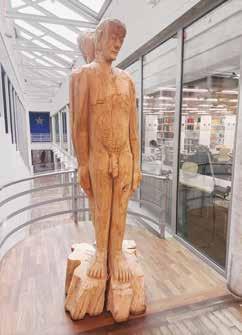
of the upper-storey gallery. This figure is female, firmly anchored to its rough pedestal. It stands back to back with a second, male figure, both positioned atop a coarsely hewn tree trunk. Looking back from this vantage point, we see above the sphere-mounted figure a blue wall piece adorned with a star. Rising behind a platform that bridges the corridor, it appears like a fragment of an artificial, emblematic sky.
Only upon closer inspection does it become clear that the star is a mosaic composed of various distinct elements. This evokes a myth from Greek antiquity, in which, following the advice of the goddess Athena, Kadmos sowed the teeth of a slain dragon—giving rise to a legion of armed warriors. Here, one might wonder what kind of “seeds” are symbolized in this mosaic, which incorporates the teeth of cattle, horses, deer, and sharks.
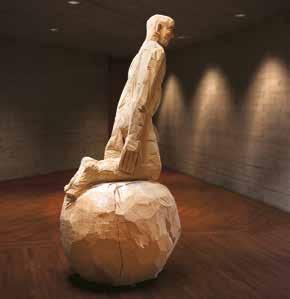
The entire group of works appears as encrypted and self-referential as the star’s symbolism: The two figures staring at each other are at an unbridgeable distance from one another and define the space between them, while the third, male figure is turning away and cannot communicate with the female figure to the back of him.
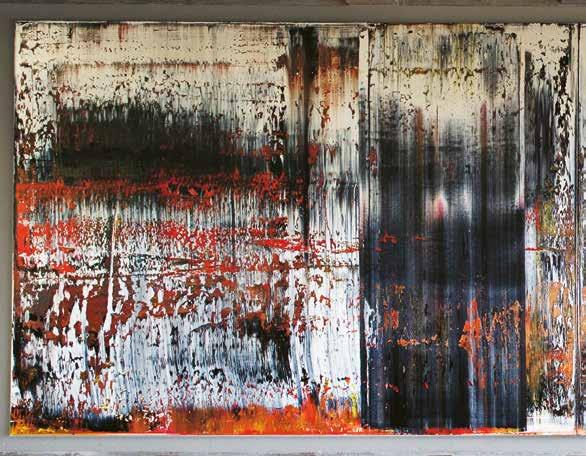
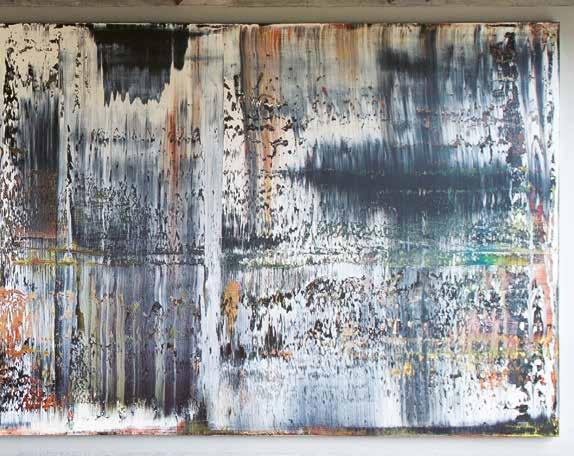
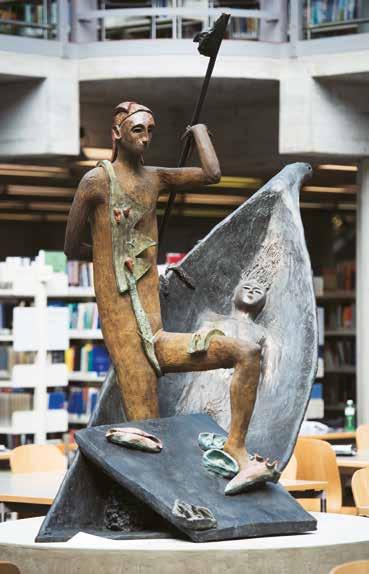

We now proceed along the connecting corridor and pass through a glass door on the left into the large new library. The bookshelves and workstations extend across two floors, with various areas in the open space meeting the students’ needs. Surrounded by desks, in the middle stands a painted bronze sculpture by Mimmo Paladino (born 1948), “Giardino chiuso”. It is directly beneath the tip of the glass pyramid in the middle of the room such that, especially when viewed from the gallery on the upper storey, it is an eye-catcher. It is no coincidence that in the midst of books and interpreted texts there is an extremely pictorial sculpture with a pronounced narrative texture. By means of diffuse symbolism and vague formal borrowing from African art, it references the Greek legend of Charon and Dante’s description of him. According to legend, Charon, the old ferryman, carried the souls of the
newly deceased across the River Styx to the world of the dead. A reference to the finite nature of all that is terrestrial in the centre of the library.
Four sets of stairs connect the two floors of the library with each other, while the wide staircase opposite the main entrance leads to the Auditorium Maximum. Having reached the last step we now encounter a large, two-part picture, a vibrating colour surface, “Illusionen” by Gerhard Richter (born 1932). A few years ago, the artist gave the painting a new name: “St.Gallen”. The colour of the painting, which is almost as big as the wall, is if anything restrained, at least as far as the final coating, which was applied vertically in black and white, is concerned. In innumerable places, however, the surface is torn and scratched, such that the coloured layers of sediment beneath the picture are visible.
On the left-hand side of the picture the exposed places reveal a fiery red which breaks through the outer layers of paint, while on the right the turbulent colouring slowly gives way to a duller brownish red, an ochre hue, and green.
It is well known that Gerhard Richter repeatedly revises his works through an extended process, with each stage representing an independent development. He carefully examines each iteration without necessarily planning the next steps in advance, allowing the artwork to evolve organically. Richter’s work is not limited to abstract painting; rather, his entire artistic output is defined by constant change and apparent ruptures. In the 1960s, he began painting images based on photographs from magazines. In these seemingly unremarkable, non-artistic photographs, Richter found a means of freeing himself from the
constraints of deliberate aesthetic composition. This approach echoes the strategy Marcel Duchamp pioneered with his readymades, challenging conventional notions of artistic intent and originality.
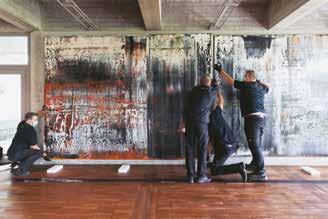
In contrast to Duchamp, who abandoned painting, Richter attempts to open up new possibilities for himself in precisely this field. He does this by emptying the mimetic content of figurative pictures in his oeuvre, and by taking the physicalism of colour, which refers to nothing other than itself, to absurd levels. Though as of the 1970s the focal point of his interest seemed to shift to abstract painting, he never on this account stopped painting figurative pictures as well. In this sense, he never differentiated between representational and non-representational paintings, as neither can ever be similar to the object they represent. Realistic works are often just symbols and have a referential character aimed not directly at what is portrayed in the picture, but at something that lies behind. They are not different from abstract pictures, as these can both refer to cosmic orders and represent colour spaces, or be colour that celebrates itself in
the act of painting. If the very notion of reference is so fragile, what—if anything— can one truly rely on in an image? As Gerhard Richter’s paintings reveal, aesthetic experience is not about recognizing reality or gaining knowledge about the world. Instead, it stands as one of humanity’s unique and independent assets. Art encourages reflective judgment and reveals the ways in which we perceive, offering insights into our own ways of seeing and understanding.
Turning round we will see on the section of wall above the stairwell leading to the ground floor the wall piece “Anima” by Luciano Fabro (1936-2007). Thin, coloured metal rods of unequal lengths are collected as a bundle and fastened to a piece of the wall covered in white plaster. On the right, the weight bends the longer ends of the rods downwards to create a springy arc, shaped by a light touch. On the left,
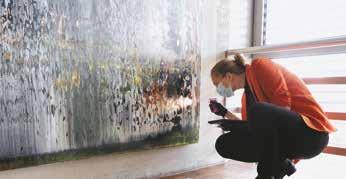
toward the window, colourful, slightly bent metal strips have been attached to the rods as a counterweight, hanging vertically downwards. The fine, golden wires that lead from the point where these shorter pendulums link to the longer rods up to the left upper corner of the wall are as good as invisible. The wall piece evolves using sparing, but highly effective means, whereby the essential element that constitutes it is the weightlessness of balance. The rods are deliberately garish in colour, making the piece seem bright and transparent, so that it looks as bodiless as possible in the incident daylight. Luciano Fabro was initially associated with “Arte Povera”, albeit not just using plain, but also decidedly precious materials.
Thanks to the elegance of the gestures and the lively colours, “Anima” has a radiant sense of lightness about it, all too easily
making one forget that in his almost intangible piece, which repeatedly takes on new, unexpected shapes, Fabro addresses fundamental questions of human existence and explores the metaphysical properties of the artwork.
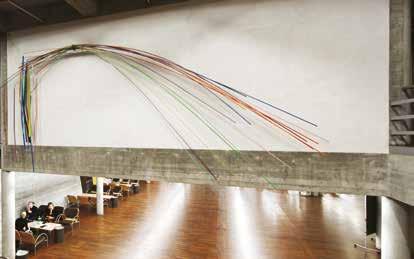
The title Anima may allude to this dual meaning—derived from the Latin word for breath or air, an apt reference to the way the work appears to float above the stairs. At the same time, anima also signifies the soul, representing the essence of organic, sensory life in contrast to purely intellectual inspiration.
In the basement of the library, near the newspapers and art books, one finds Nicole Tolle’s (*1970) installation “Heaven & Hell”. The work tackles a subject rarely explored in art—the ambivalence of the financial market. While money has not been a dominant artistic theme, it has recurred throughout art history, particularly in works with a critical stance on capitalism. In recent years, artists such as Andrea Fraser, Walid Raad, and Tino Sehgal have powerfully demonstrated this engagement, offering thought-provoking critiques on economic systems and their influence on society. Harald Szeemann’s exhibition Money and Value – The Last Taboo, commissioned by the Swiss National Bank for Expo 2002, was unflinching in its critique—most notably featuring a money-shredding machine that left no room for subtlety. Especially in Helvetia’s tax haven and strong
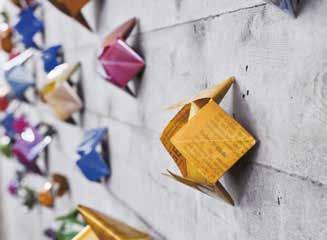
financial sector, according to the common assumption, the topic is also difficult for artists. The dictum “You don’t talk about money“ is still strongly internalized in this country, and the art world rarely criticizes banks head-on.
Nicole Tolle’s installation serves as a seemingly fragile yet poignant reminder of the events surrounding the downfall of the St.Gallen-based Wegelin private bank. Its dispute with the U.S. Treasury, which peaked in 2012/13, had far-reaching consequences—ultimately contributing to the globally coordinated framework for the automatic exchange of financial information on foreign taxpayers’ accounts.
On closer inspection of Tolle’s piece one recognizes text fragments from newspaper clippings of the time, which illustrate the heated climate. The title of the
artwork, “Heaven & Hell” and the folded newspaper articles—coloured to resemble banknotes and shaped according to the children’s game of the same name—serve as a reminder that financial market decisions, though based on calculations and analyses, are ultimately driven by the full spectrum of human emotion. This installation, which deals with the Wegelin case, is intended to remind students and staff of the considerable consequences for the Swiss banking sector, the country’s oldest bank had to be closed in a dispute with the USA. To this end, St.Gallen historian Dr Peter Stahlberger has written a short chronology of the events at the time, which can be followed via QR code.
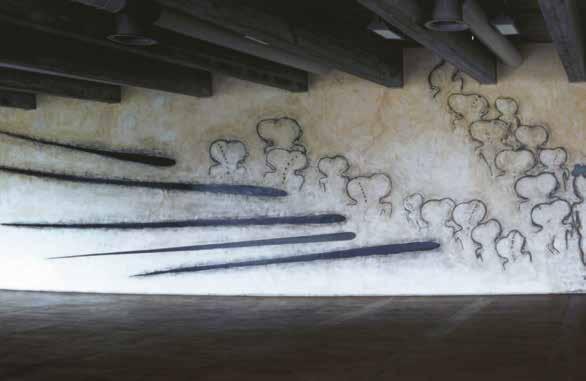
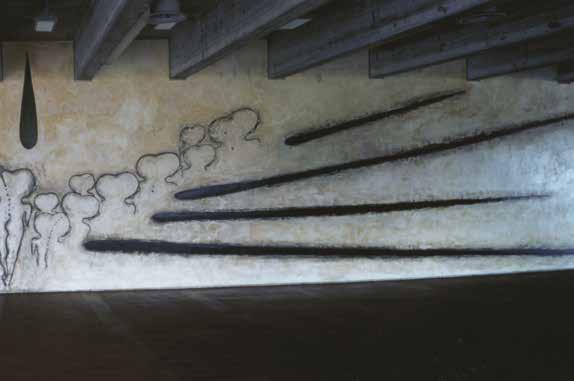
As in the entrance hall, on the upper floor, the foyer along the curved real wall of the main lecture theatre is also accessible, whereby along the gallery railing there are comfortable chairs inviting you to tarry awhile, with windows in front providing ample light. From here there’s a great view of the centre of the mural by Enzo Cucchi (*1949). The painting is composed of a layer of plaster and honey and spreads across the entire length and breadth of the wall. The curvature in the composition is discernible when you look at the image’s central figure – an embryo- like being with an outsized double head; with
its back to us it steps into the depths of the picture. It appears at this point to both scatter the pictorial content and to hold it together. The notion of a stable axis is emphasized by the drop-like shape made of tar, which descends upon the above described figure and the cloverleaf emanating from its head. This is highlight- ed by the other elements in the image (three staggered rows one behind the other, likewise of head shapes divided in the middle and nine drops or rays tapering toward the edges) again intimat- ing a movement that accelerates outwards and which we viewers associate with the curve of the wall.
Enzo Cucchi’s pictorial world thrives on portrayals of archetypes that he seems to cull from some collective unconscious. Perhaps he also refers ironically to the activity behind the wall in the lecture theatre, where students with hypertrophic brains sit in rows of seats staring captivated at the centre, whence the knowledge radiates outwards. In his large-format paintings with their complex compositional schemes, Cucchi manages to conjure up enigmatic visions of the end of time from the depths of his own intuition.
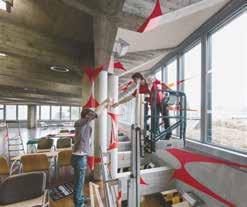
A piece from Felice Varini (*1952), an artist living in Paris but originally from Ticino, was installed in the top floor of the library building in 2014. “Dix disques évidés plus neuf moitiés et deux quarts” challenges and sharpens our perception of dimensions, shifting it from three to two and then back, whereby our visual acclimatisation is well and truly scrambled. It also pleases the illusionist Varini if we do not even discover the two-dimensional resolution and the floating planes, thus failing to solve the riddle.
The concept of art in architecture is perfectly embodied here – in between installation art and painting. Felice Varini works in open space with simple geometric forms and primary colours, which reveal themselves to the observer from a single point. A small movement is enough to resolve the system. Together, the supposed fragmentary chaos and the

geometric, static order contained within only reveal the dialectic whole in an endless loop of de- and reconstruction. It is always possible to return to the one point and escape the chaos. Upon the first encounter with the red fragments in the three-dimensional space, we inevitably ask ourselves whether there is something there which we have yet to notice. Varini consciously chooses simplicity of form and colour, because our steps and perception already create a sufficient sense of unease that surrounds the artwork.
The red, painted on backgrounds, is complemented by transparent film on the windows, which further intensifies the playful, distortive effects created by the invasion of light and finds new spaces through the illuminating red projections, even on the ground floor. Across thirty years of creativity and counting, Varini finds surfaces on which to cast his
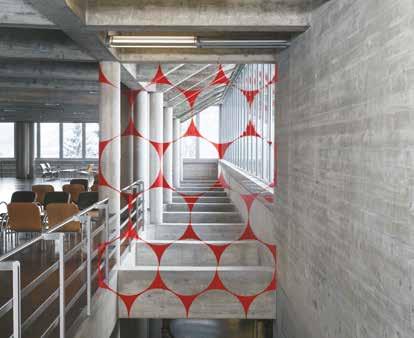
projections almost all over the world on walls, façades, floors, concrete piers, gates, windows, balustrades. His entirely personal dramaturgy, an anamorphosis, soon teaches us that all insight is a matter of perspective.
Closely coupled with the architecture, the installation creates an unexpected connection to another artwork in the neighbouring main building. The red mobile by Alexander Calder, with its organic forms, is constantly moving and generates various constellations of sculptures and pictures in two and three dimensions – both autonomously and through the constantly changing perspective of the observers passing by. The red pliage by Gottfried Honegger at the Kirchenhoferhaus also changes markedly with each step we take, generating a different geometric figure.
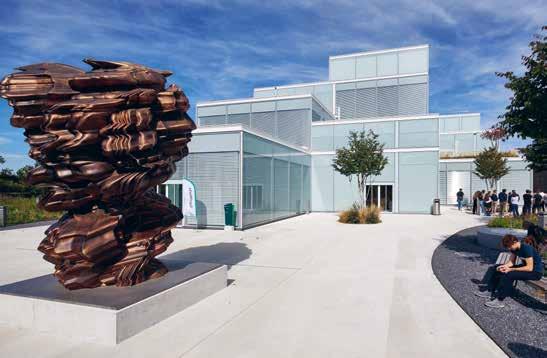
In front of the main entrance to the SQUARE stands the massive bronze sculpture “Ourea“ (2021) by Sir Tony Cragg (*1949). The title of the work refers to the ancient Greek term for deities personifying mountains. The volcano Etna is regarded as an Ourea. These are two organic forms of Cragg’s work: the lava flow and the mountain landscape with its minerals and fossils. Natural and technical sciences (engineering) are important sources of inspiration for the artist’s monumental yet intricate structures. The sculpture, with its massiveness and its organic forms, presents a stiking contrast to the playful yet strictly geometric stacking of glass cubes of the building. The piece belongs to the group of works “Stacks”, which, in the case of Ourea, also extends into the interior of the sculpture. Along three layers and three interlocking
columns, layers of bronze moulds are stacked on top of each other. The flowing contours perceptible from the outside evoke associations with water or landscapes, swirls, and gently vibrating movements, curves, and fractals. In the textile city of St.Gallen, one is also tempted to interpret the layers as folds of fabric. However above all, in the twisting and turning forms, the viewer can discern faces in profile and body shapes.
Stacking runs like a common thread through Cragg’s work. In his early works, he stacked objects of glass on top of each other and formed figures with plastic waste. This was followed by bronze sculptures reminiscent of upturned vessel parts. This category of work includes “Early Forms 1996”, which is located in front of the foyer of the Center for Executive Education (see page 129). HSG owns works by only a select few
artists. The second sculpture by Tony Cragg acquired almost 30 years after the first, is a gift from an alumnus and serves as a testament to the artists evolution — demonstrating how, after decades, he continues to work with the same material while creating something entirely new, yet unmistakably his own. The two works differ not only in their horizontality and verticality. While “Early Forms 1996” plays with the alternation of inside and outside and reference to man-made vessels, “Ourea 2021” recognizes only the outside and is based exclusively on organic forms.
Nevertheless, Cragg’s distinctive artistic signature is immediately recognizable in both pieces.

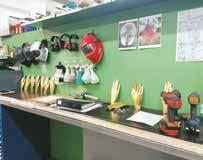

Not immediately apparent on entering SQUARE, the view reveals the filigree 60 meter long chain by the Genevan artist Mai-Thu Perret (*1976) in the central atrium of the building. The golden chain with the Buddhist title and the 121 objects winds its way up from the floor of the ground level up to the concrete columns on the ceiling. The view is stimulated to follow the course of the chain, whereby the forms and the interplay of columns, architecture, and pendant objects become a 360-degree experience. The pendants on the chain comprise 15 different repeating motifs: Body Parts, Eye, Ear, Brain and Hand, which are associated with the interplay of learning and teaching, as well as symbols borrowed from science including some patterns and ornaments of archaic origin. The bracelet with pendants reminiscent of “Lucky Charms” allows the artist to provide students and researchers at the factory of thought with various
lucky charms on the path to understanding. The serpentine lines suggest that the paths that result from thinking do not run in a straight line, but often take unexpected and arbitrary turns. Perhaps these paths conceal an allusion to Hannah Arendt’s “Thinking without railings”, because the work with its golden, warm colour also creates a rambling, ornate, but also free counter-design to the crystalline, glassy architecture of the building. Made from hammered or cast sheet brass at the St.Gallen art foundry Sitterwerk, the regional craft is also prominently represented in the artwork.

Mai-Thu Perret | “Through the forest of thorns, a single path”, 2022, brass chain, 60 meters, objects of hammered brass
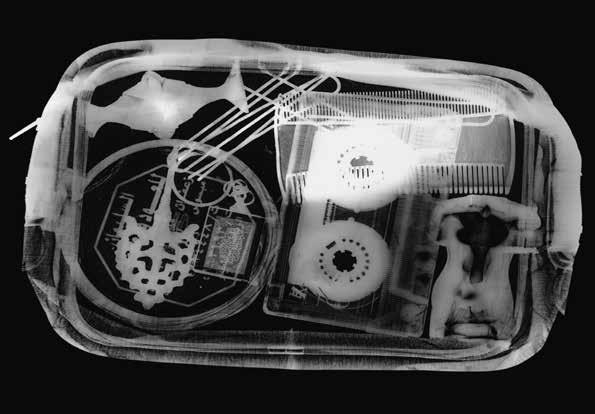
On the first floor of SQUARE, on three opposite walls, are to be found the C-Prints, of the Saudi Arabian artist Maha Malluh (*1959). The three prints refer to the frequent screening of her luggage at airports. The X-ray images of various pieces of hand luggage carry a subversive element, as Maha Malluh subtly projects or “smuggles” additional objects into the X-ray image, challenging the viewer’s perception.
This slightly alienating add-on undermines the control function of the baggage scanner and distinguishes the artist’s prints from the purely functional control view of the airport staff. The photos can also be read as a cipher of constant surveillance with justification or under the guise of security. But the scans at the airport do not always manage to make the distinction between suspicious and harmless objects. The title of the series
refers to the still life in the pieces of luggage, that mixes local with global, traditional with modern, and commonplace with symbolically charged objects, e.g., an Arabic jewelry pendant with a tape cassette, a comb, key ring, or beauty product. The use of X-ray images in art contains mainly physical motifs from the field of medicine, mostly skeletons, from which Maha Malluh’s everyday objects stand out.
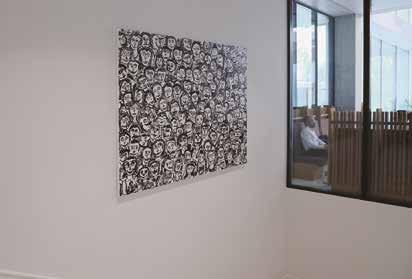
A huge new painting by well-established Swiss artist and musician Klaudia Schifferle (*1955) will be placed on the staircase wall leading down to the basement of SQUARE. As the University of St.Gallen is growing steadily and space is scarce, students and staff will recognize the spatially dense situation on campus. While the artist associates the painting with her perspective from the stage during one of her concerts, the black-andwhite, comic-like acrylic painting finds a counterpart in Ingo Giezendanner’s high-density urban landscape, which was acquired by HSG at the same time.
A wild diversity of faces observes us, laughing, talking, discussing, perhaps even singing. It refers to the onomatopoeiaetic title “Lalü Lalü”, which the artist herself compares to speech bubbles in cartoons. The restless conglomerate of streaks represents different moods of the
collective crowd, most of them bright, cheerful, but also frightened or timid faces, who throw piercing but also discreet glances at us.
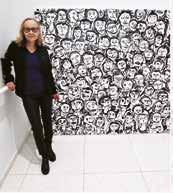
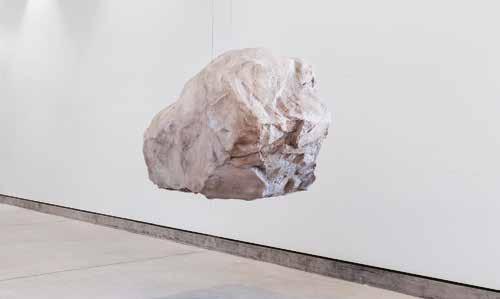
Jose Dávila | “Seeing is Believing”, 2021, Fiberglass and metal wire, 250 cm x 150 cm x 150 cm, 60 kg
In the basement of SQUARE, we find the floating stone titled “Seeing is Believing” by Mexican sculptor and architect José Dávila (* 1974) from Guadalajara. He tests contradictory and illusionary materials and effects, challenging the viewer’s perspective of architectural principles such as gravity, balance, or proportion. In the case of the massive stone, at first sight, one wonders, how the thin metal wire can support such an immense weight.
However, this turns out to be an illusion; the stone is actually made of fiberglass, a strong, flexible type of glass-reinforced plastic that can be easily molded. This manipulation or deception raises awareness about the ease of blurring the line between appearance and reality, fact and fiction. At the same time, the artistic maneuver invites us to engage in what Samuel Taylor Coleridge described as the
“suspension of disbelief”—the willingness to immerse in a fantasy and fiction. The title of the sculpture reflects this concept: what we believe we see turns out to be something entirely different.
The floating rock’s mimicry, even in its white-grey colour, blends seamlessly with the building where it has “landed.” José Dávila explores stones as one of the “most primitive forms of both construction and sculptural work”, in this case, transformed to sculpted, weightless fiberglass balancing out dense mass and fragility.
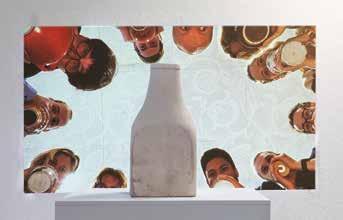
Anita Zimmermann | “Vase chant”, 2023, video-loop 3:36 and vase object
Anita Zimmermann (*1956) has lived and worked in the city of St.Gallen as an artist and as a curator (Leila Bock) important for the art scene of Eastern Switzerland. In the basement of SQUARE, we catch sight of a projector on the ceiling, and below, a white pedestal on which stands an object cast by the artist, representing the vase series in the video. In it, we see flower vases as resonating bodies or unusual sound transformers or instruments of the concert that Anita Zimmermann spontaneously organized with students, staff, and the president. The frog’s-eye view of the camera places the acoustic ceiling at the center of the filmed choir singing. The acoustics at SQUARE were the starting point for the artist’s work. Two groups of actors in a circle were commissioned to sing an improvised melody of their choice into the collected vases. Thereby, they created a soft, ghostly sequence of sounds or fluctuating octaves. The muffled,
heterogeneous songs without words miraculously come together and form an entity, a choir. For the artist, as an outsider to the University, it was fascinating to observe how students and staff reacted to the curious endeavor—whether with rejection, embarrassment, or amusement.
Under no circumstances should the experiment be seen as a swan song or final act. Instead, it aims to encourage greater openness toward such playful and engaging artistic interventions.
The unprepared vocal performance of the two groups of twelve and five, including the artist, plays with an absurd situation. It sounds restrained and quiet, and with the extraordinary acoustic vibrations and signals, the white vase sculpture invites the passers-by to pause for a moment and ask questions about the ambient contents.
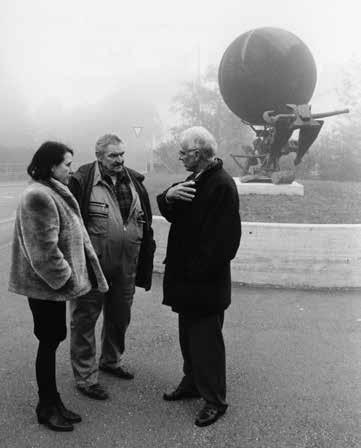
Transparent and light, possibly a little futuristic – those are some of the terms one hears when the talk turns to Bruno Gerosa’s design for the Executive Campus at the University of St.Gallen. Playfully Baroque on Zollstrasse, the structure resembles a UFO that has landed in a meadow when viewed from the front. So, what kind of artwork could a building that inspires such comparisons house without detracting from its unique character? Initially, only one: a floor piece by Jan Dibbets that referenced the architecture, and given the WBZ’s perfect white walls and glass fronts, it seemed this would remain the case. Eventually, the Art Committee at the time decided that, apart from the outdoor spaces, only the no-frills, functional cafeteria warranted an artistic intervention.
On our tour, we approach the WBZ from Holzstrasse – it stands somewhat apart from the other university buildings – and what we first encounter is an ensemble of rural idylls. An old farm-house, a massive lime tree, in front of it a martial sculpture by Bernhard Luginbühl (1929-2011) and the Executive Campus’ extension wing, which juts out like a block into the countryside. The farmhouse is home to offices and a goods lift to the underground car park. The circus with the lime tree forms the borderline between the section rooted in tradition and the experimental, new. Seen this way, Bernhard Luginbühl’s “Anchor Figure with Roll” (1993) is perfectly placed in this location. The imposing monument features a massive sphere resting on a relatively delicate plinth, while an anchor, swinging out at an angle, appears to counterbalance the weight.
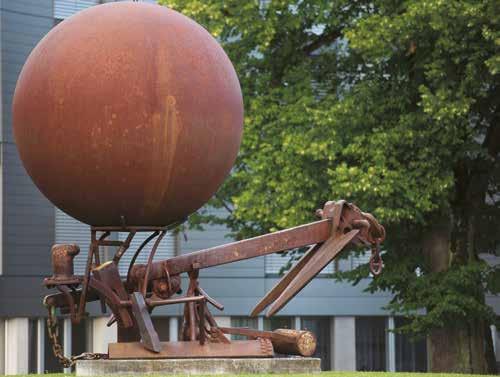
Luginbühl’s relentlessly rotating sculptures, constructed of industrial waste, do not celebrate the triumph of technology. Instead, they somehow resemble remnants of a long-extinct archaic culture. These primordial, cloddish titans, despite their often astonishing balancing acts, do not embrace the machine aesthetic that once heralded a new era with optimism. Rather, they serve as a reminder of the transience of human achievements, no matter how grand.
After this sombre beginning and the passage through the WBZ building, which blocks off the countryside, a new, more joyful scene awaits us: the HSG Executive Campus proper gleams brightly in its white marble cladding. Long is the avenue running up to it and the courtyard, crossing lightly sloping terrain, until you reach the revolving door to the entrance and the central dome behind it. Two
transparent foyers mark the endpoints of the two wings and feature glass façades with wave-like curves.
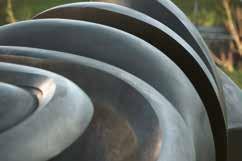

In front of the foyer, to the right of the somewhat longer wing and positioned at an angle that emulates the movement of the glass façade, lies the long shape of the bronze sculpture «St.Gallen» of the series “Early Forms” by Tony Cragg (*1949). At first glance, one could be forgiven for thinking it is quite a traditional sculpture – a classic material used in an organic, plant-like idiom. It is thus with slight irritation that one spots the structure of an bowl of everyday use that forms the basis of this elegantly laid-out body, whipped up into spiral-like turns. In his work, Cragg uses not only bronze but also likes to include trivial everyday items made of plastic, combining them to form new configurations. His interest lies in the object itself and in how society interacts with the countless objects it continuously produces.. He studies the objects, investigates their visual properties, and tries to place them in a context that enables us to
experience them anew in an original way. The way we treat objects today is emphatically careless, leading to their wear and tear; Tony Cragg aims to restore the autonomous dignity that objects once possessed—back when we still understood how they were made and carefully sought to develop those “early forms” entrusted to us. His efforts, therefore do not focus primarily on the aesthetic of the material or the form, but on the social mechanisms that, in the final instance, most enduringly change the objects.
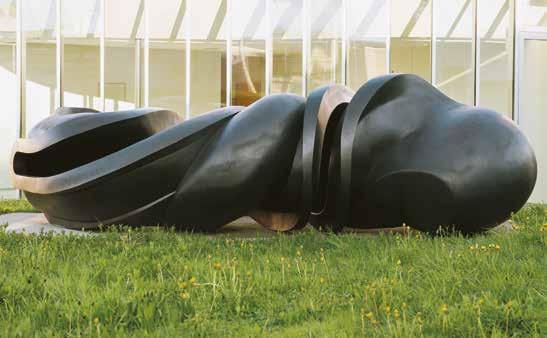
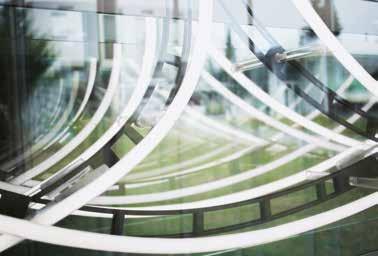
Brigitte Kowanz (1957-2022), an Austrian artist of international standing, realized one of her last works at the Executive Education Centre (WBZ) of the University of St.Gallen shortly before her death.
Kowanz’s interest since the 1980s was the relationship between space and light, two essentially immaterial phenomena. To visualize them, the artist primarily used fluorescent bodies, transparent glass, and mirrors. At the same time, she combined the potential information carrier “light” with human language, since 1995, and also with the binary Morse code. This enabled her to integrate into her works “encoded” texts, e.g., of literary or political character. The aesthetically sophisticated work, considering both the interior as well as the exterior space in the glazed side pavilion of the WBZ consists of five mirror boxes, an aluminum strip, and a neon tube. The aluminum strip contains the Morse code of the two title-giving dates, which refer to
the presentation of the World Wide Web (www.) at CERN (March 12, 1989) and to the day on which the first website went online and, thus, the Internet became publicly accessible (August 6, 1991). As Brigitte Kowanz wrote, the work conveys ”a kind of biography of the World Wide Web, whose encoded form reveals at the same time its historical origin and foundation.”
The data-carrying aluminum strip right behind the neon tube follows its loopshaped course, which is reminiscent of the cable as a means of transmitting information. The mirror boxes serve the tape and tube as “housings” and multiply their image from the finite to the infinite and thus from the real into the virtual.
According to the artist, the work refers to the fact, “hat the Euclidean image of the world and space [our sensual-empirical
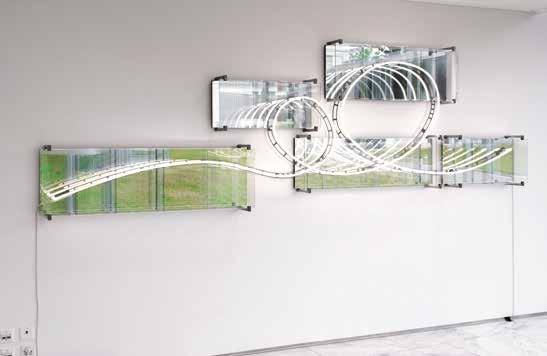
image of it] under the conditions of mediatization and the virtualization of reality has dissolved.” This understanding corresponds to the almost immaterial and ephemeral appearance of the work.
On a sunny day, visitors are greeted by an almost dazzling light inside the Executive Campus, for the bright stone and white walls give even greater power to the sunrays – and much sunlight enters the building through the transparent dome and the glass walls. What strikes the eye is that the foyer is defined by round shapes: curved or radial walls, flowing staircases, the semi-spherical domes, and exactly beneath them, the circular openings that pierce through the floor and offer a view of the storey below, which houses the café and bar. If we bend over the railing and look down, we can see why Dutch artist Jan Dibbets (*1941) was inspired by these shapes when creating his piece on the floor of the lower story. The circular shape of the opening has been projected onto the floor. The harmonious system of circles gets interrupted, but square floor plates made of the same stone as the rest of the building have been inserted into the
predefined circle to create a cruciform with a black outline that breaks out of the circle. Dibbets has made a minor amendment to the structure set by the building, namely the symmetry and the circle that predominate within the WBZ building, creating a slight shift. The cross, having slid from the centre of the circle, can be read as a kind of axis for coordinates that somehow evade the gaze of the viewers above and introduce a quiet moment of irritation to the perception of the space.
Jan Dibbets’ works often focus on minute changes and sparing interventions, leaving us wondering about the main perspectives in a given space. Photographic montages undermine a clear vantage point. Essentially, Dibbets is indebted to a painterly tradition, given the way he explores angles and the viewer’s position. However, he does not address these issues in an illusionist’s pictorial space but
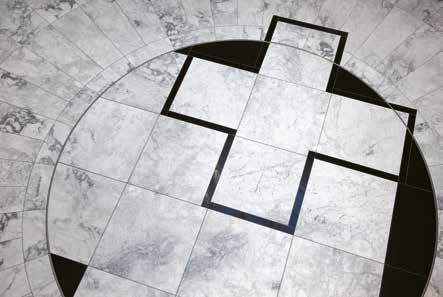
transposes them into the three dimensions of space in order, as it were, to invert them: Instead of constructing a figurative illusion on canvas, he deconstructs the perspective of real space. The spacious, two-story foyer serves as the Executive Campus’ communicative and ostentatious heart.
This lobby connects the lecture halls, seminar rooms, and administrative offices on the ground floor with the café bar, restaurant, and teaching rooms on the lower floor. It is here that the paths to individual lecture rooms intersect, yet people do not simply pass through without notice. Instead, the foyer functions as a forum in the classical sense—a space for meetings, conversations, and social interactions.
It is a place where people gather, whether to sit in the black Philippe Starck arm-
chairs or on the iconic Landi chairs out on the terrace, enjoying the view in front of the large glass façade.The gaze wanders from the gallery out into the countryside, inspired by the architecture that has created such a cultured climate. In conscious contrast to this, the seminar rooms have been designed simply as “labs” for concentrated study. We can end the tour by visiting one of the hospitality rooms, the “Intermezzo” restaurant on the lower floor, located in one of the two circular wings that define the endpoints of the foyer on either side.
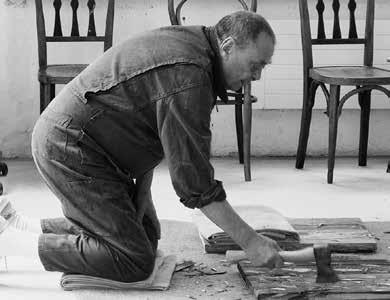
The framed woodcuts by Günther Uecker (*1930) in the stairwell of the Executive Campus create a direct dialogue with the building’s dominant colours—black and white. They particularly resonate with Jan Dibbets’ floor inlay and also relate to other artworks, such as Tony Cragg’s sculpture Early Forms, displayed outside the building.
Their placement follows the progression of the stairs, offering observers multiple vantage points to appreciate the works both up close and from a distance. Uecker’s woodcuts fundamentally correspond to his objects and reliefs. Material, surface, structure, movement, light, and shadow stand in the foreground here. The prints Man and Woman and Seven Trees were created using a printing block (wood, for example, an old, weathered tabletop) that has been worked with an axe (see photo). Lacking a
suitable printing press for the oversized format of 290 x 150 cm, Uecker worked for days on end using his body weight for the printing process. The woodcuts were then finally peeled off by hand.
Günther Uecker created his pieces through intensive bodily exertion, often using axes, hammers, and nails. The aggressive action, the violation of the materials, the sharp contrast of black and white ultimately refer to the great existential themes, with which Uecker has concerned himself from the beginning: people and society, nature and technology, life and death, growth and decay, danger and liberation, the visualsation of aggression.
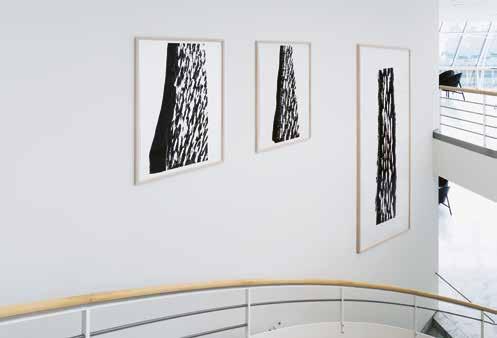

Günther Uecker | Man and Woman, 1990, woodcut on laid paper, 290 x 150 cm each, signed, edition of 40, Erker-Presse St.Gallen
Günther Uecker | Seven Trees, 1985, (Tree I – IV), woodcut on laid paper, 105 x 75 cm each, signed, edition of 20, Erker-Presse St.Gallen

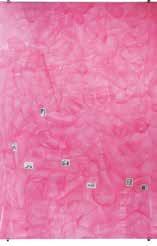

Anselm Stalder (*1956), (*1956), who has placed his “Lo sguardo raddoppiato” here, felt the room was “cool”, as the tone of the interior of the restaurant is determined by white walls, glass, and epoxy aluminium. Its footprint is a ring segment, with the back wall formed from glass tiles, and on the valley side, five windows open out onto the countryside. For Anselm Stalder, this room is in movement. He compared it to a section from the platform of a carousel, and his piece is intended to heighten this impression of imaginary spinning. He has positioned glazed, unframed passe-partouts between the windows. Their different sizes all reference the mass of the windows. Stalder describes the passe- partouts’ colours as “yellow ochre, light rose, dusty green, anthracite, dusty green again, deep radiant ultramarine, and then at the end yellow ochre again.”
This row of colours is strongly accentuated on the wall to the foyer, where the side lengths of a square in “intense warm red” replicate the diameter of the only small round window. The sequence of colours gives rhythm to the space, infusing it with movement. When the eye returns from the last yellow-ochre surface back to the first, it seems as if still dazed from the spinning of the carousel; the sudden standstill comes as a slight backwards turn. The movement arises based on an illusionary perception of things.
All the passe-partouts contain small drawings based on press photos that “float like a handful of scattered stars in colour fields”. Anselm Stalder’s poetic description reveals that he is no artist dedicated solely to a conceptual and constructive world. His monochrome surfaces do not follow a strict colour system, but on closer
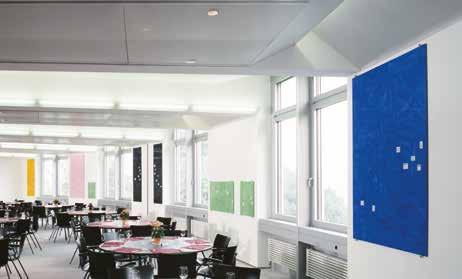
inspection, they are the bearers of intimate messages and stories that tempt viewers to move closer and study them.
In conclusion, we leave the main Executive Campus building and walk to the Hans Ulrich Hall, at the end of which the last two of a total of seven new acquisitions are located: Félix de la Concha’s “WBZ Panorama” and Elisabeth Nembrini’s animal projections.
Anyone walking up the stairs to another floor in the Executive Campus’s Hans Ulrich Auditorium at St.Gallen University, crosses motion sensors that trigger the temporary daylight projection onto the wall of various slides: There’s a parakeet with wings widespread; a poodle with a putto; a fox with a walking stick and pipe. While the sudden appearance of an image is itself surprising, the very size of the shots is most certainly so: approx. 3.5 x 2.5
metres and thus far beyond the natural scale of the respective theme, such as the parakeet, transforming the cute household pet doomed to live in a cage into a free and menacing “bird of prey” flying toward users of the stairwell. And the way the poodle has been shorn, arbitrarily to fit some human taste, is off-putting: be it the miniature putto attached somehow nonsensically to its hind legs, be it the pose the dog has adopted, somehow risible and yet pitiful, in an attempt to assert itself, visible only thanks to this extreme enlargement. The fox exits the animal kingdom world – walking upright and with utensils definitely not associated with it, entering the world of fable, of humans but still in an animal form.
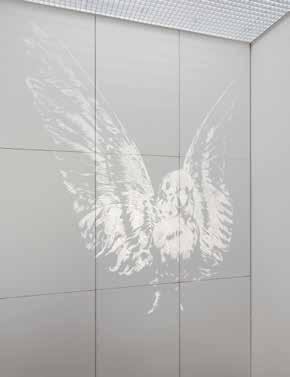
The respective slide screened is based on an image that Elisabeth Nembrini (born 1960) either herself photographed or borrowed from other sources, for example magazines or the Internet. The original image is then computer-reprocessed artistically, reducing it to the essential substance and in design terms of pure chiaroscuro. Nembrini then projects the image onto a glass plate coated in white emulsion and, using a little wooden rod, carefully scratches away the paint in line with the outline and hatching. While the artist originally conceived of the resulting drawings on glass as independent works hung on the wall, she then moved on to the logical idea of reproducing the drawings on an expanse of wall using a daylight projector; this second projection not only gives the subject matter an intensified presence, but given the outsize proportions also creates a more alienated image.
Elisabeth Nembrini | «Milky Way: Wellensittich, Pudel, Fuchs», 2012, 3 Glasplatten, jeweils 29,9 x 29,3 cm, mit Dispersionsbeschichtung und herausgekratzter Zeichnung auf Hellraumprojektor (mit Bewegungsmelder), Projektionsgrösse ca. 350 x 250 cm
When selecting and processing the themes chosen, which on principle cover everything visible in the outside world, Elisabeth Nembrini is primarily interested in alienation and surprise, in the enigmatic and the unsettling, the oscillating state of the moment with no reference to what went before or comes after, free association and “surreal friction”. At the same time, the visible does not dissipate in the incomprehensible, as the attentive viewer will discern in these slide images of budgerigar, poodle, and fox before domestication, indeed the animals’ degradation by Man. What reason can there be for placing a stuffed fox standing upright with a walking stick and pipe on a gambling machine and, discovered and recorded photographically by Nembrini, then placing it in a display window? A vague allusion to Reynard the Fox? What cause can there be for transforming a hunting dog into a soppy dog and then


disfiguring its fur with fashion threads such that the original wild and dignified canine is no longer to be recognised? And does the parakeet, however much it is bred, not defy the narrow confines of its cage and “remember” the expanse of its indigenous country of Australia?
Nembrini is not focussed on animal rights but on creating critical aesthetic attention for all those phenomena of contemporary reality, be it in our real surroundings, be it in the media. Elisabeth Nembrini refers to the image that we make of reality and how it can be cast into question by the images she creates and places next to it. Further education helps you expand your horizons, helps you modify your existing angle on things, and helps you gain new ones. Thus, a panorama such as that created by Félix de la Concha (*1962) is metaphorically predestined for its location here. Based in Iowa, the Spanish artist has
developed a marvellous visual circle for HSG, which, on the one hand, and true to vision, presents the realities of what is to be seen close up and far away with great precision and mood, incorporated into a stunning curvature. On the other hand, the viewers’ customary ways of seeing and expectations are playfully subverted. Accordingly, the panorama is duplicated in the loggia portrayed, and at the same time, it is not quoted in the outside view of the Executive Campus. Various viewer vantage points are ingeniously combined to form a flow of images while synchronically different phases of time are established in the work’s here-and-now. The time spent developing the panorama from the first sketch to the complete ten-part painting is thus subtly stored within the image thus created.
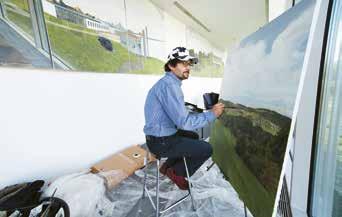
The image within the image within the image—a pirouette of perception: standing in the loggia, with the broad canvas before your eyes and the real world behind you, your sense of orientation is unsettled. As you look back and forth, comparing reality with its depiction, you encounter Félix de la Concha’s masterful compositional hard cuts and skilful distortions of perspective.
Each of the ten pictorial elements is intrinsically coherent, governed by a strict compositional structure. The horizon lines and central axes align seamlessly with the underlying themes and poignant details of the images— nothing is left to impressionist chance. Instead, the artist deliberately guides the viewer, captivating both visitors and students with this multi-faceted pictorial aperçu of the seat of learning.
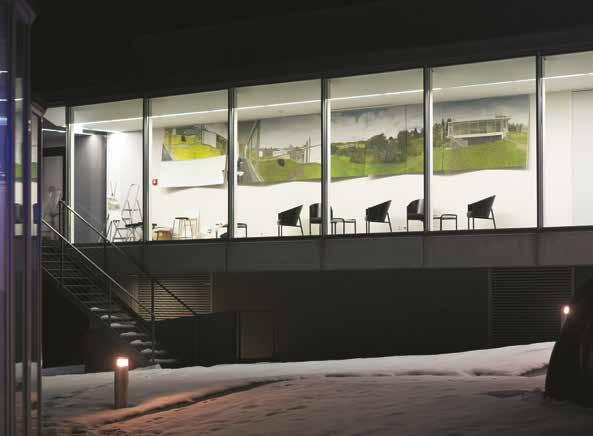
Félix de la Concha | “WBZ Panorama. Through the Looking-Glass”, 2012, polyptych consisting of 10 panels, oil on canvas, 960 x 136 cm
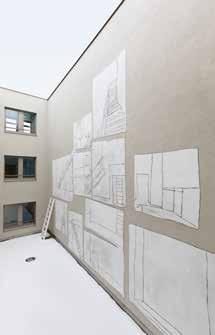
Müller-Friedberg-Strasse 6/8
Zilla Leutenegger | “Staircase: Lonely at the top”, 2018, drawings on 11 tableaux in sgraffito technique, 10.5 m x 9 m and a wooden ladder, veneered in white
For the first time, the well-known Swiss artist Zilla Leutenegger (*1968) has used her newly acquired sgraffito technique on a large wall of one of the atriums at Müller-Friedberg-Strasse 8. The work “Staircase” covers three (5th to 7th) floors. The artist scratched off the upper plaster layer, thus exposing the underlying layer of a different colour. The sparse, archaic line of Zillas Leutenegger’s drawings ideally combines the sgraffito method.
On the one hand, the staircase motif reflects the building’s architecture, where multiple stairwells and corridors intertwine rhizomatically, forming a threefloor labyrinth. On the other hand, this networking may reflect a cipher to interdisciplinary encounters
in interstices, passages, and corridors, or to direct collaboration inside the building. While the beholder of the artwork mostly spots only sections, the eye finds it difficult to grasp the big picture.
The subtitle “Lonely at the top” refers to the figure of Zilla, a kind of alter ego of the artist who, sitting alone in a space on the top floor, plays with the light cone of a lamp. In the manner of her video drawings, Zilla Leutenegger is planning to produce a video installation to animate and project the oscillating light cone of the lamp. Just as ironically as Randy Newman sings his 1987 song Lonely at the Top, the artist also alludes to the isolation of leaders—those who may receive their training at the University of St.Gallen and ascend multiple career ladders.
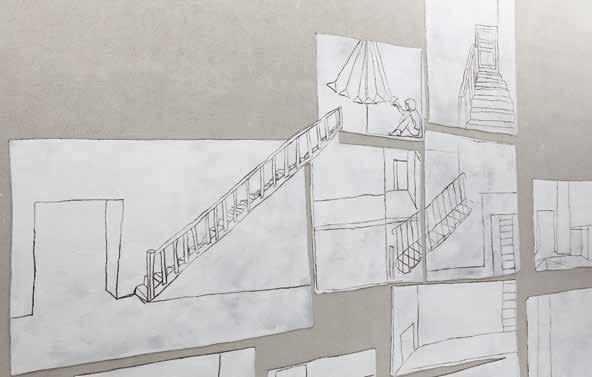
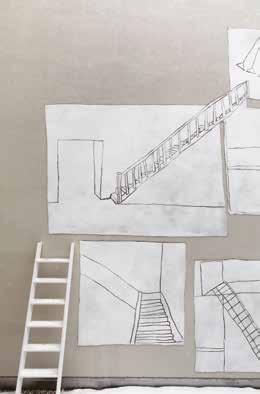
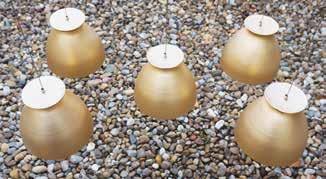
In the left atrium of the fifth floor, we find the work “ESTA CANCIÓN” by Swiss artist Susanna Niederer (*1958). Nine groups of bell sculptures mounted at different heights, consisting of five bells each, are suspended from individual inox cables. Employees and visitors entering the atrium can make the bell sculptures ring. The resulting chime fills the entire volume of the atrium and gives the neighboring offices around the atrium colour and sound. Niederer’s long-standing fascination with Japanese culture comes to the fore in the groups of bells because, as the oldest musical instrument, bells without heads, which were struck from outside during ritual rites, were first documented in Asia. The work also draws a local connection to the nearby Abbey district. Irish travelling monks, among them St. Gallus are said to have carried handbells with them and thus for the
first time from the 5th century brought bells from Ireland to Central Europe and anchored them in their function as callers to the church service. Susanna Niederer’s bells also enter into a direct dialogue with the role of the university as a caller, warner, and border crosser. Dividing lines between sculpture and music, between the individual and society, dissolve, opening new perspectives on their interplay. In this atrium, no bell sounds on its own—the soundscapes emerge solely from the collision of individual bell ribs.
Susanna Niederer’s bells reflect her leitmotif of the (here halved) ellipse and recycling art. She repurposed discarded aluminum ashtrays from Asia, once filled with sand for cigarette disposal, coating them in gold, transforming them into objects of resonance and meaning. Also distributed throughout this building
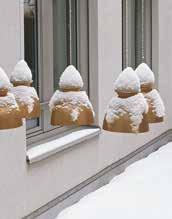
Susanna Niederer | “ESTA CANCIÓN”, 2022, aluminium, powder-coated, inox cable, and steel 125 x 160 cm
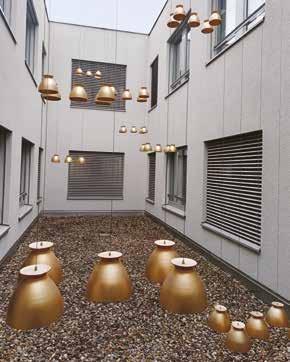
on the walls of the corridors are series of lithographs (from the former erker Gallery, St.Gallen) by Uecker, Tàpies and many more as well as Betsabeé Romero’s eight colour photographs of alienated, ‘decorated’ cars from the Daros Collection Latin America.
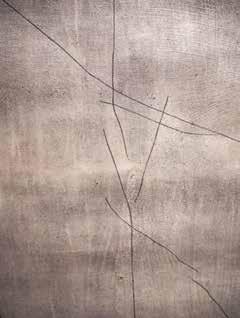
“Washington House” Rosenbergstrasse 20-22
For the opening of the new university building next to the railway station, in May 2024, the “Haus Washington” in the immediate neighborhood of Tellstrasse 2, Beate Terfloths (*1958) two paintings “ – what is in my hands” 1997) have been installed. The exploration of lines has always been at the center of Beate Terfloth’s artistic work. The couple picture represents the lines of two hands as a cipher for the past and the future of the course of life, especially the foresight of existence. The artist uses thick, socalled

miniature paper, on which, in the Islamic world, coloured miniature paintings as well as the hand lines in this particular case can represent a whole life, indeed the whole world. Beate Terfloth primes this paper with iron slag (like the black tuning circles on the Indian tabla drums) and draws on it hand lines with a reed pen and Chinese ink. The quiet work creates a contemplative atmosphere and emphasizes the haptics of the hands in contrast to the digital work. The relieflike lines and vibrations, but also furrows, plough through the surface of the hand, dark grey on brown. Condensed and yet sparing, calm and at the same time nervous,
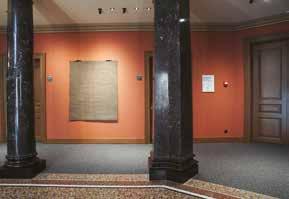


Beate Terfloth: “was in meinen Händen ist”, 1997, reed pen drawings (Chinese ink) on slag on miniature paper, 200 x 147 cm each
Photo | Marcel Bischof, 2025
porous lines, dark, but somehow reflecting light. The abstract lines (in contrast to micro painting) symbolize large-format concrete life.
The slightly erratic template of the hand lines is drawn, as in miniature painting, with a reed pen and ink as instruments of calligraphy. They are translated very precisely into the ink lines on the earthy ground of the palms and the two large papers. They do not tell of boundaries and dividing lines but connect the surface via the ramifications of a very own language of strokes.

While this artwork has been moved to Washington House from a site not publicly accessible anymore, a coherent concept has been developed for the rest of the building. Together with students from the HSG Master certificate «Managing Climate Solutions» (Prof. Rolf Wüstenhagen), who are researching how art can support climate solutions, art photography motifs were selected for display. Several works, grouped into four themes—WOODS, WATER, GLACIERS, and ANIMALS— were arranged mainly in tandems. As this booklet is being published, the process is still ongoing, not all the works can be shown here. The remaining presentation will be roughly outlined.
Seven out of ten artworks have been installed, the tandems GLACIERS and WOODS, completed. Two more photographs and the huge woven sculpture in the courtyard between the Washington
House and the building at Tellstrasse 2 will follow soon.
WOODS features a tandem of Swiss artists Monica Ursina Jäger (*1974) and Olaf Breuning (*1970), both of whom work internationally— Breuning in Upstate New York for over two decades and Jäger in Zurich and London (raised in St.Gallen). His “Complaing forest” is a sculpture photographed by the artist, in which Breuning uses small wooden sticks to create speech bubbles expressing grievances with moaning and groaning noises, with which the forest articulates itself against ecological issues. It is located on the ground floor of Washington House, while Jäger’s work is positioned directly above it on the first floor, in the large niche next to the rear elevator.
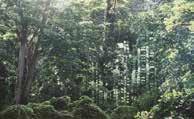
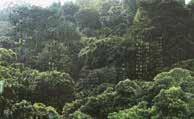
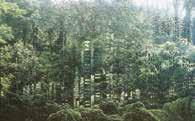
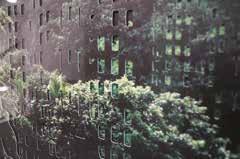
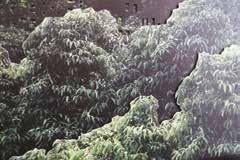
Breuning’s forest is joined by Monica Ursina Jäger’s triptych of collages of photographs and papercuts of Singapore’s natural and urban landscapes. With her extensive experience in the megacity, she has interwoven the region’s forest and green lung in the urban center with the dense and heated silhouettes of skyscrapers (social housing blocks) presented as papercuts. In this multi-layered panorama, the viewer cannot distinguish which one of the two spaces invades the other. In that sense, the title of the series is telling: the intermingled, oscillating “topographies” become ambivalent between urban
deforestation and greening. The paper cuts symbolize the fragility of all things, giving the urban buildings a threedimensional quality. Both papercuts and wooden sticks share a sculptural approach, expanding and complementing art photography by adding layers of materiality and depth.
The coincidence that Monica Ursina Jäger’s father was once President of the University of Applied Sciences when it was located at Washington House brings a personal dimension to the installation, closing a family circle for the artist.
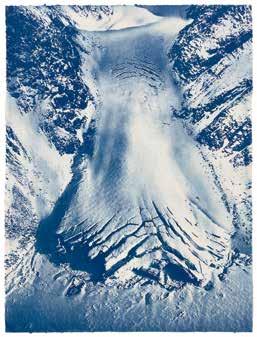

Two further Swiss artists form the tandem GLACIERS, Daniela Keiser (*1963) and Laurence Piaget-Dubuis (*1971). Their work addresses the (dying) glaciers in the Alps and beyond. The two glacier tongues with the appealing, ambiguous title “The Tongue in Translation” by Daniela Kaiser, based on her elaborate cyanotype technique, are placed on the grey-blue left-hand wall on the first floor of the building. Keiser closely observes natural structures, drawing analogies to human thought
through varied deep-blue tones in cyanotype. Nearby, Valais eco-artist Piaget-Dubuis presents an image of the Rhône glacier, protected with white cloths, placed in a protected niche on the white wall. At the center of her photography is the reaction of nature to climate change, particularly in mountain landscapes.
Both artists have spent long periods doing research in empathic coexistence with the glaciers, which are very fragile

beings. The grey and white atmosphere of the shrinking Rhône glacier with a human intervention of the ladder and the huge cloth transformation or “translation” of pure white into grey is visible on this photograph. The light splits the image into two, with the ladder standing at the center. The folds of the protective cloth as well as the textures of the rocks and the snow/ice can be seen pin-sharp in this amplified photograph (no photoshop intervention) and resemble drapes, which remind us of Renaissance art.

On the beige wall parallel to the banister at the main entrance of Washington House, Francisco Sierra (*1977) has installed his oil-painted miniatures on wood (7 x 7 cm) of “Betta splendens” or Siamese fighting fish—sick, overbred ornamental fish—on concave niches. The meticulously painted small-scale fish appear created in a style similar to photorealism, but without the use of stencils. Francisco Sierra mounts the paintings on wood, cut out of wine boxes, on convex wall reliefs, further enhancing their dimensionality. This miniature aquarium of ornamental tropical fish on tiny wooden pieces challenges the relationship between overbred pets and human intervention in nature, questioning the extent to which humans manipulate and alter life forms.
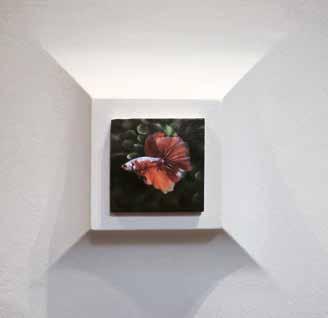

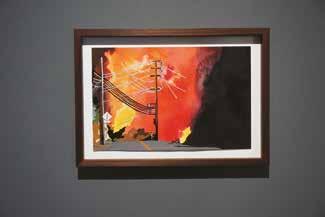
The art piece by Canadian artis Francesca Gabbiani (*1965), based in Los Angeles, addresses water scarcity.
Using gouache and the complex technique of ‘colored paper-cuts on paper’, she achieves a level of detail that closely approaches photorealism—similar to the work of Sierra and Hesse-Honegger.
Gabbiani’s paper paintings combine layered cut paper, collaged on top of one another, to create depth, along with mixed-media washes and airbrushing. Her works follow her own photographic documentation of damaged environments, highlighting the serious issue of forest fires, which regularly affect the region where she lives.
Her two artworks are displayed on the grey-blue wall on the 4th floor of House Washington. The first, “2018 Trancas Canyon”, is named after a large park in Malibu that was affected by wildfires. The second of the burning palm trees, with the enigmatic title “Dear Yvette”, also an old US Rap song by LL Cool J, refers to the Celtic and Germanic origin of the name Yvette, which stands for the robust yew tree and symbolizes resilience and eternity, quite telling in the context of wildfires. Her painterly and sculptural coloured paper collages are charged with a “subtly uncanny” atmosphere.

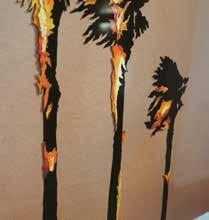
The second one of the burning palm trees, with the enigmatic title “Dear Yvette”, refers to the Celtic and Germanic origin of the name Yvette, which stands for the robust yew tree and symbolizes resilience and eternity, quite telling in the context of wildfires.
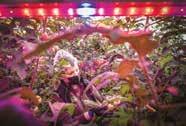
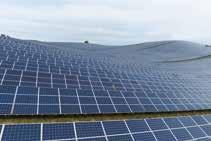

The three artistic, documentary photographs by award-winning photographer Simone Tramonte (*1976) will be displayed in the same location as Jäger’s and Breuning’s photographs, but on the 3rd floor. His series “Net Zero Transition”, from which the images selected for the Washington House were taken, has received numerous accolades, including the World Press Photo 2023 award and Pictures of the Year International 2022. This particular compilation highlights the contrast between the outdoor space, where the photovoltaic system blends into the landscape like a natural mountain formation, and the interior of the greenhouse depicted in the two smaller photographs, where natural vegetables appear in a strikingly artificial and colourful setting.
The solar park, in the middle, is seamlessly integrated in the mountain landscape generating clean energy for 12,000 households. The hydroponic growing method reduces 70% of water usage for irrigation (compared to traditional crops).
Simone Tramonte visited several sites across Europe, which present innovative technologies leading the way to transition towards climate neutrality and a net-zero economy.
The same Italian greenhouse, on the left and on the right, allows all-year-round tomato harvesting grown in a controlled environment, no external pollutants, no need for herbicides and glyphosates. Its system of circular economy uses 100% green energy from the nearby biogas plant fueled by the very plants of the greenhouse.
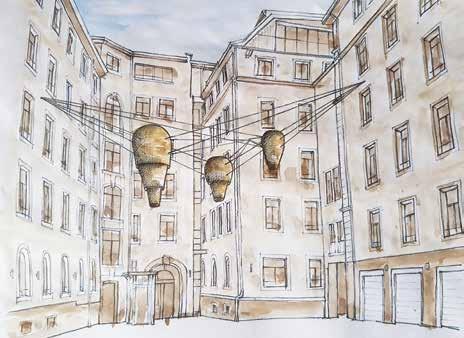
The lights on the photograph on the left create a whole prism of colors and combines the jungle-like environment of green leaves with dominant red-violetpink tones. This aesthetic context functionally embeds the tomatoes’ growth process, of which the woman worker takes care. The same Ferrara greenhouse on the righthand photograph shows a more technical context of huge dimensions in natural daylight and plain green plants.
The second Italian photographer, Armin Linke (*1966), will present a similar setting of climate solutions in Bangladesh. His artwork shows an indoor rice-seed vault in the middle of an ecological farm and will be placed in close proximity to Simone Tramonte’s tryptic.
Roger Rigorth’s (*1965) four sculptures, made of natural materials and classified as environmental art, resemble beehives and thus complement the themes of the photographs inside the building. Suspended on steel cables, these sculptures will hang in the large inner courtyard between the two HSG buildings Tellstrasse 2 / Rosenbergstrasse 20-22. The largest of the three woven archaic structures stands at four metres high. The artist’s sketch illustrates the planned installation.

In addition to the long-term concept of “art in architecture”, HSG was able to organize a more dynamic, temporary exhibition. Every year, five artists of all over the world showcased their work in the University building next to the railway station, at Tellstrasse 2. The idea was developed together with the same HSG alumnus, who fully financed the project. The exhibitions, primarily curated by Thamar Ette, followed the model of providing the artists with the opportunity to gain more visibility outside the marketplace and within the context of a renowned university collection. The prerequisite for the emerging artists to apply was that they were not (yet) to be represented by a gallery. In response to the first call, 740 artists applied, from which five were selected to come to St.Gallen from Mumbai, New
York, São Paulo, South Korea, and Sosnivka/Ukraine. In 2016, art@tell (later U/Art) gained momentum: with a selection of five works from a total of 15 artworks shown to date, the project went abroad for the first time, offering a guest exhibition on the campus of our partner university, WU Vienna.
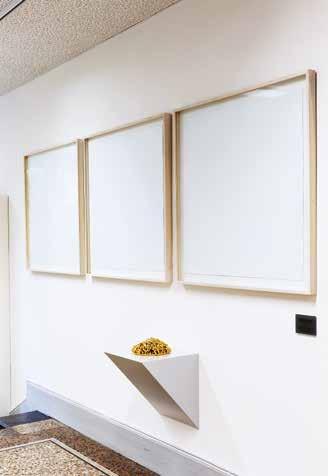
Raúl Rebolledo | The fool’s gold, 2014, 3 handgefertigte, geprägte Papierarbeiten, je 100 x 100 cm, vergoldetes Keramikobjekt, Durchmesser Ø 25 cm Photos: © Marko Seifert
At the end of the five-year cycle, the patron donated one of the works to HSG, Raúl Rebolledo’s (*1977) “The Fool’s Gold”, which can now remain in St. Gallen permanently, alongside three other temporary loans. The artist from Guadalajara first confronts students and employees of Tellstrasse with gilded surfaces, only to then subvert traditional value systems through three framed tableaux. He independently set the price for each of piece, disregarding galleries, secondary markets, or speculations. This sum corresponds to the cost of 25.06 g of
cocaine, 625 cartridges of caliber 7.62 (AK47 automatic rifle), and the Mexican minimum wage of 169,262 VSM (Veces Salario Mínimo). These nearly imperceptible equivalents are delicately stamped onto handmade papers. With this work, Raúl Rebolledo not only engages with the stereotypical perception of Mexico— linked to drugs, violence, and poverty— but also raises the pressing question of art’s value, creating a conceptual tension that ultimately collides with the stark realities of the world.
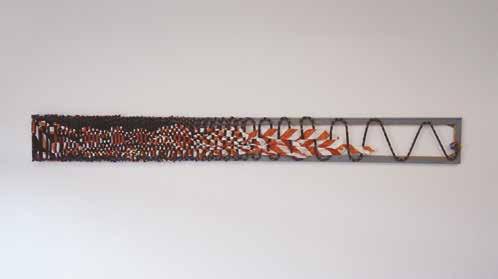
Fridolin Schoch | “Final Sprint” (2020), climbing band, barrier tape, acrylic, and stretcher frame, 30 x 281 cm
Photo | Marcel Bischof, 2025
On the ground floor of the HSG building at Rosenbergstrasse 30, in the co-working space, Appenzell artist Fridolin Schoch (*1989) has placed his relief “End spurt” / “Final Sprint” (2020). Created of recycled materials sourced from construction sites and incorporating a climbing band, the work reflects themes of progress and challenge.
The use of repurposed materials resonates with the informal work and ongoing studies in this space. The elements of the relief symbolize both the ascent of climbing a mountain and the obstacles encountered on a long and winding path, embodying the perseverance and setbacks inherent in any journey. Moreover, the interweaving of plastic construction fabrics and a nylon climbing rope in a metal-wooden framework provide a textile surface to the art piece. We might associate with these multiple entanglements the complex networks of today’s existence.
Committee President Prof. Dr. phil. Yvette Sánchez
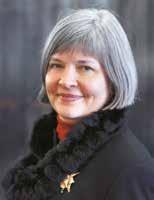
Art in architecture at HSG is a phenomenon unique worldwide in a public university. Superb art pieces have been installed overthe last fifty years and unpretentiously accompany students and staff in their working routine. Nevertheless they, those who are not per se art-affine, get sensitised for the cause and get into close and low-threshold contact with art. Some explicit and implicit effects on students of a business school are undeniable, not only since the art market has become so relevant, and art is more and more integrated into management trainings. The high-calibre collection, which is also permanently accessible to the public, which reflects the HSG’s holistic educational approach.
For 57 years, artists have been invited to cultivate the connection between science, art, and architecture and to create their works. The more than 50 important pieces by regional and international artists would be a credit to any museum. The architecture has a lot to offer, also with buildings planned for the future. Since 2011, we have been in the fourth
phase of expanding our site-specific artworks. After the successful modernization of the Main Building, the HSG Campus on Rosenberg was extended, and the extension wings to the Executive Campus HSG Holzweid were commissioned. In a relatively brief period, we have acquired several new pieces, and others will follow, also for future buildings.
The Main Building was opened in 1963, the completion of the Library Building followed in 1989, and the first tract for the Executive Campus in 1995. Each of them has stimulated new acquisitions. The current Art Committee aspires to push ahead the collection in the spirit of the pioneering trio, Prof. Dr. iur. Eduard Nägeli and architect Walter Förderer, with the support of curator Harald Szeemann. The new buildings will be furnished with artworks in line with the founders’ concept; these artworks will not be staged as if in a museum but ”simply” as an essential part of everyday campus life. International and regional artists have been invited to realise
sitespecific pieces at HSG. Some of them were lucky strikes: Alberto Giacometti, Georges Braque, Hans Arp, Alexander Calder, Joan Miró, Antoni Tàpies, Gerhard Richter, or Roman Signer are among the names that resonate strongly. It is noteworthy that no tax money has ever been applied for these acquisitions. Instead, they were financed from the very beginning by private donations. The Art Committee is responsible for fundraising to acquire each selected piece.
Projects are elaborated on site by the artists, thanks to personal contact with them. This close relationship is apparent in some of the photos in the present brochure, showing the artists at work and illustrating how the projects evolved. As the collection grows, so does the number of coincidental or intended linkages between the individual works. Several artworks depend strongly on perspective.
From a distance, Gerhard Richter’s painting or Pierre Soulages’ tapestry look so very unlike what you see when studying the painting or weaving
technique at close range. A self-reflecting landscape dissolves when you stand directly in front of Richter’s painting into a complex structure of countless layers of paint. A first glance from afar sees Soulages’ immense brushstrokes but, on closer inspection, they turn out to be a matter of minutely controlled, millimetre precision. His black calligraphy-like symbols create a connection with the signs in Joan Miró’s tiled frieze. With each of our steps, Alexander Calder’s (intrinsically moving) mobile changes, just as Gottfried Honegger’s pliages then become to the viewer a constant work in progress. This effect reaches the most intense variant in Felice Varini’s anamorphosis.
The figures, themes, and genres also forge various links between individual works. Calder’s organic structures made of sheet steel refer to Alicia Penalba’s organic forms of cement on the lawn outside the Main Building, which in turn point to Jean Arp’s nearby “tree of bowls”. The latter corresponds to François Stahly’s “fountain tree”, which leads us to
Honegger’s pliages, alluding to Walter Bodmer’s hanging sculpture in primary blue, red, and yellow in the building next door.
Mimmo Paladino’s Charon enters into dialogue with the neighbouring three archaic tree-trunk figures by Joseph Felix Müller. These again are counterpoints to the small, tender, well-protected Alberto Giacometti sculpture, horizontal in thrust; heavy and massive, by contrast, Bernhard Luginbühl’s and Tony Cragg’s non-figurative sculptures outside the Executive Campus. Jean Baier’s aluminum wall pieces can be compared to Lothar Baumgarten’s enamel panels; just as Roman Signer’s videos somehow relate to the studio photographs resembling Teresa Hubbard & Alexander Birchler’s film stills in the cafeteria, or Alejandro Díaz’s neonlight sculpture with Elisabeth Nembrini’s slide images made of the daylight projectors that play an important role in media history. The figurative and very large self-portrait in oil by Yan Pei-Ming speaks to Félix de la Concha’s panorama image and Martin Disler’s Expressionist painting interacts with that of Gerhard Richter. Such chains of association can be continued at will,
also by contrasting characteristics: The strong physical presence of Josephson’s worker, taller than life-size, with Julian Oliver’s critique of digitalisation in the small form of a grenade.
In connection with the paintings by Hubbard & Birchler at the Mensa in the main building, the photograph of the famous Henri Cartier-Bresson, who, in the sixties, photographed the fascinating free-hanging concrete staircase of said building. The stairs deserve a special mention. The impressive black and white photograph, published in the Swiss magazine DU (1967, no. 8), sets the concrete staircase with four seemingly randomly interacting male figures so skilfully that the staging is not only reminiscent of Oskar Schlemmer’s famous Bauhaus staircase pictures, but also of the artificial atmosphere of Alain Resnais’ film L’année dernière à Marienbad (1961). An additional dimension to this mood was added by the world-famous architectural photographer Iwan Baan’s photos of the Akris anniver- sary collection, taken there without any artificial light. The similarities with the Cartier-Bresson photo are astonishing starting with the identical perspective. 55 years lie in between the two photographs.
Alongside the overt and covert linkages between the works, it is also interesting to see how some of them not only help shape their immediate architectural surroundings but also interact with everyday work at the University of St.Gallen. Martin Disler’s choice of title, “USURA” (Usurious Interest), ironically hints at one of the topics taught at a business school. Alejandro Díaz’ neon slogans are a warning aimed at consumerism and advertising. Lothar Baumgarten’s equations at the entrance to the Library Building most manifestly address HSG teaching content. We have already mentioned Enzo Cucchi’s reflection of what happens behind his back in the main auditorium. And Roman Signer’s “spinning bottles” from an art performance in the same auditorium should not be taken too literally; in German, bottle means dead loss …
These and other cross-references within the collection imply the impact the marvelous artworks, permanently accessible to the public, have on students, staff, and visitors alike.
The status accorded to cultural studies at the St.Gallen business school (all students must gain 25% of their credits in this field) is superbly underlined by the Art collection.
Fittingly, the student association proArte aims to introduce students and external visitors to the University’s artworks.
In general, students tend only to notice the works en passant, yet they regard them with the greatest respect. This can be seen, for example, from the fact that in the 55 years the collection has existed, not a single work has been mistreated in any way. In recent years, student interest in art in their day-to-day environment has grown sharply, and art is increasingly incorporated into teaching activities.
Roman Signer’s 14 video works as well as Felice Varini’s anamorphosis probably attract the most attention, not least because this is a genre that directly appeals to the current student generation, raised on moving images. Hardly anyone simply walks past the videos and instead at least casts a fleeting eye over the projection; many stop and comment on the images. A group of students even played
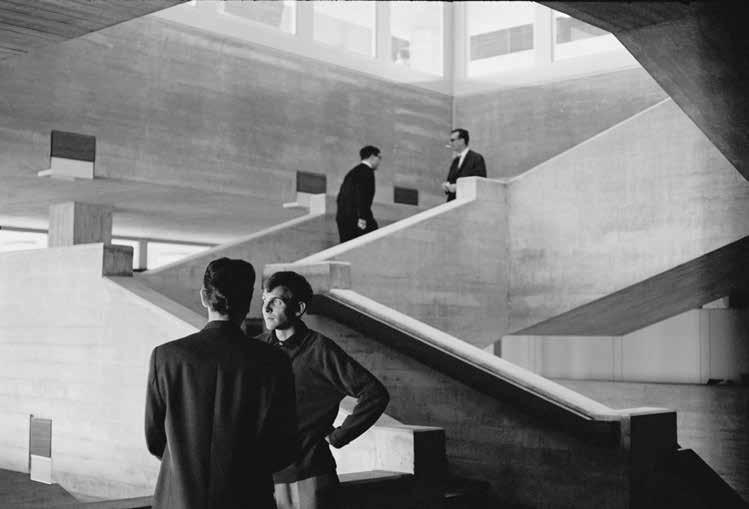
out one of the 14 Signer videos (“Kajak”, 2000) in a humorous vein and shot their video entitled “Blasphemia”. The original shows the artist paddling a kayak across a gravel path, accompanied by cows; next to them flows a quiet brook.
The students slightly changed the constellation, replacing the cows with a running dog and the gravel path with a meadow; reference is readily apparent. Staff members and students regard the collection as a symbol of the institution’s high regard for them.The existing works are viewed with pride and admiration.
Visitors are forever surprised by the art, as the collection’s status corresponds more to that of a museum than a business school. The publically accessible artworks have dispelled many a prejudice about the University of St.Gallen.
We are grateful to Gabrielle Boller for her texts of the 1998 Art Guide (marking the 100th anniversary of the founding of the University of St.Gallen), which we have excerpted for this volume. She also provided a commentary on the architectural renovation and extension undertaken up until 2011. Our thanks also go to the members of the Art Committee for the detailed descriptions of the collection’s fourteen new acquisitions. We appreciate
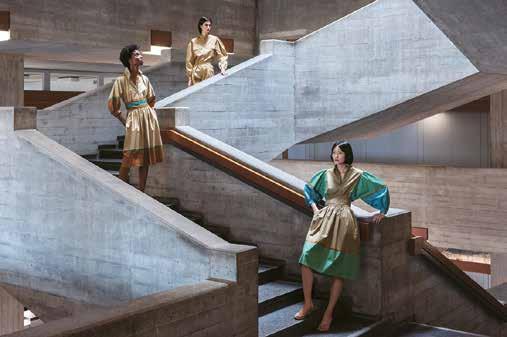
Iwan Baan, Photographs 2022, taken in the Main Förderer Building of Albert Kriemler’s designs (1979–1992) on the occasion of the 100th anniversary of Akris and the 125th anniversary of HSG © Iwan Baan
Marcel Bischof’s and Hannes Thalmann’s contributions to this brochure; their photos and graphics deserve high esteem, also Alicia Amrbruester’s proofreading of the mansucript. Finally, my cordial thanks go to all the members of the former and the present the Art Committee for their great voluntary contributions, as well as the University of St.Gallen’s presidents, who have always attentively and generously supported the collection’s interests.
Members and deputies of the Art Committee 2025
Prof. em. Dr. phil.Yvette Sánchez, President / Prof. em. Dr. Dr. h.c.Thomas Geiser, Labor Law
Prof. Dr. Blagoy Blagoev, Organization Studies / Prof. Dr. Martin Eggel, Private Law
Prof. Dr. Christine Abbt, Philosophy / Prof. Dr. Anna Elsner, French Studies
Prof. Dr. Sascha Spoun / Prof. Dr. Martina Montauti, Teaching staff’s representative
Cristina Alvar / Alicia Armbruester, Students’ representative
Dr. Bruno Hensler, General Manager HSG, ex officio
Erol Dogouglu, Cantonal Architect St.Gallen, ex officio
Cathérine Hug, Curator Kunsthaus Zürich
Gianni Jetzer, Director Kunstmuseum St.Gallen
Advisors:
Tim Kramer, Director SQUARE HSG
Thomas Lehmann, Architect St.Gallen
René Schoch, Head Real Estate HSG
Dr. Uwe Wieczorek, Former Curator Hilti Art Foundation
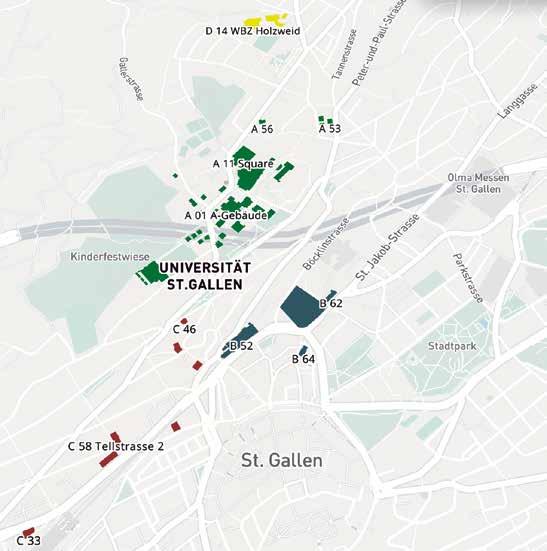

Impressum | © 2024 Universität St.Gallen (HSG)
Requests for guided art tours:
HSG Events Office | T 071 224 27 91 | fuehrungen@unisg.ch
Art Committee | Prof. em. Dr. Yvette Sánchez | T 071 224 25 66 | yvette.sanchez@unisg.ch
Students Association proArte | proarte@shsg.ch
Text | Members of the Art Committee and Gabrielle Boller
Graphic Design | Marcel Bischof, www.marcel-bischof.ch
Photographs | Unless otherwise indicated: University of St.Gallen, Hannes Thalmann, www.hannes-thalmann.ch
Print | Typotron AG, Wittenbach
Edition | 3000 copies
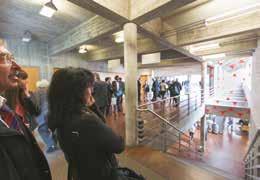
It all depends on the point of view:

IT students
an

